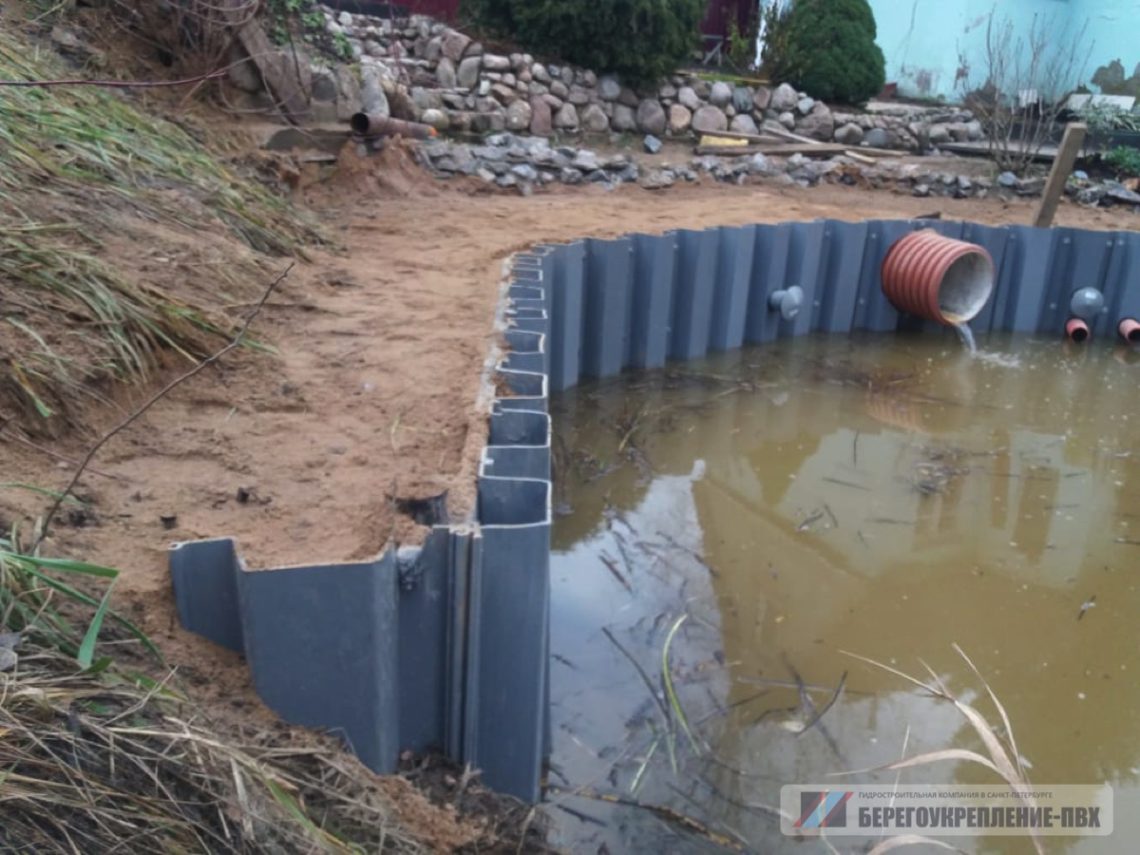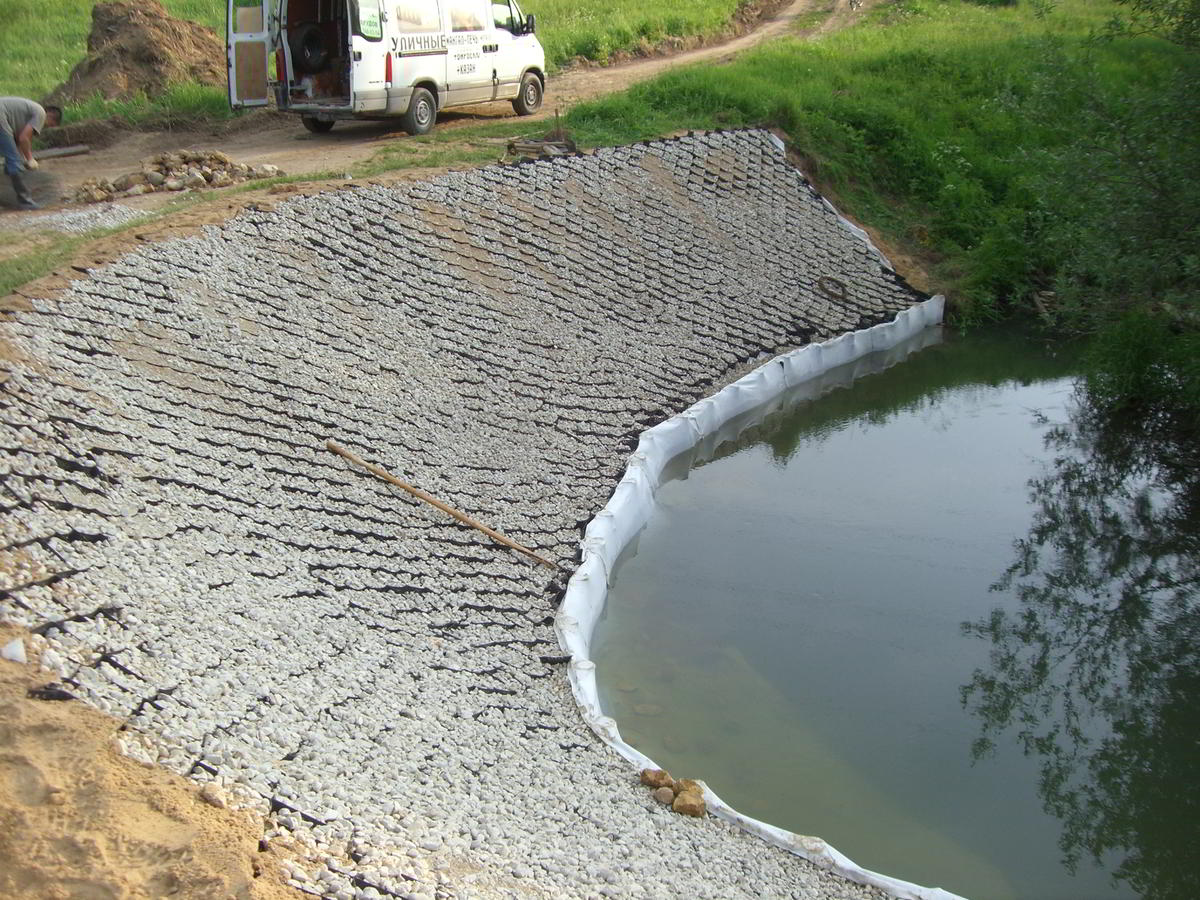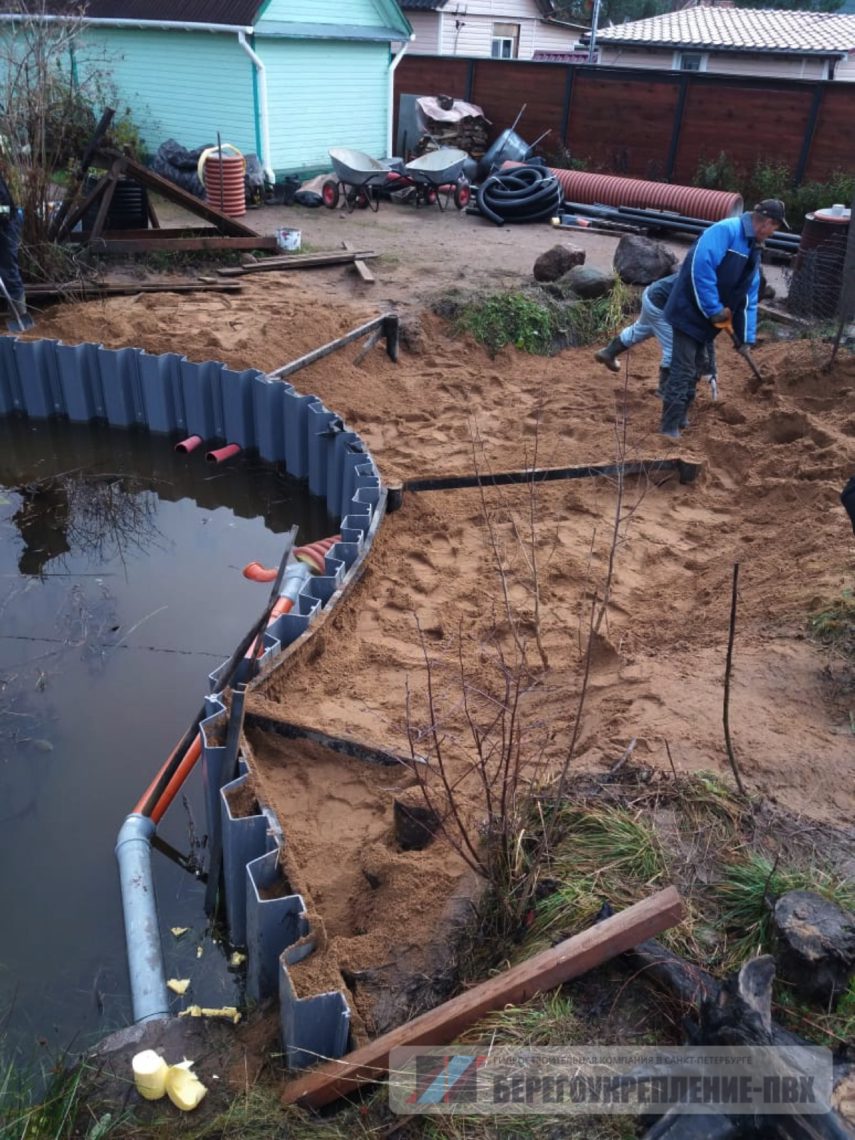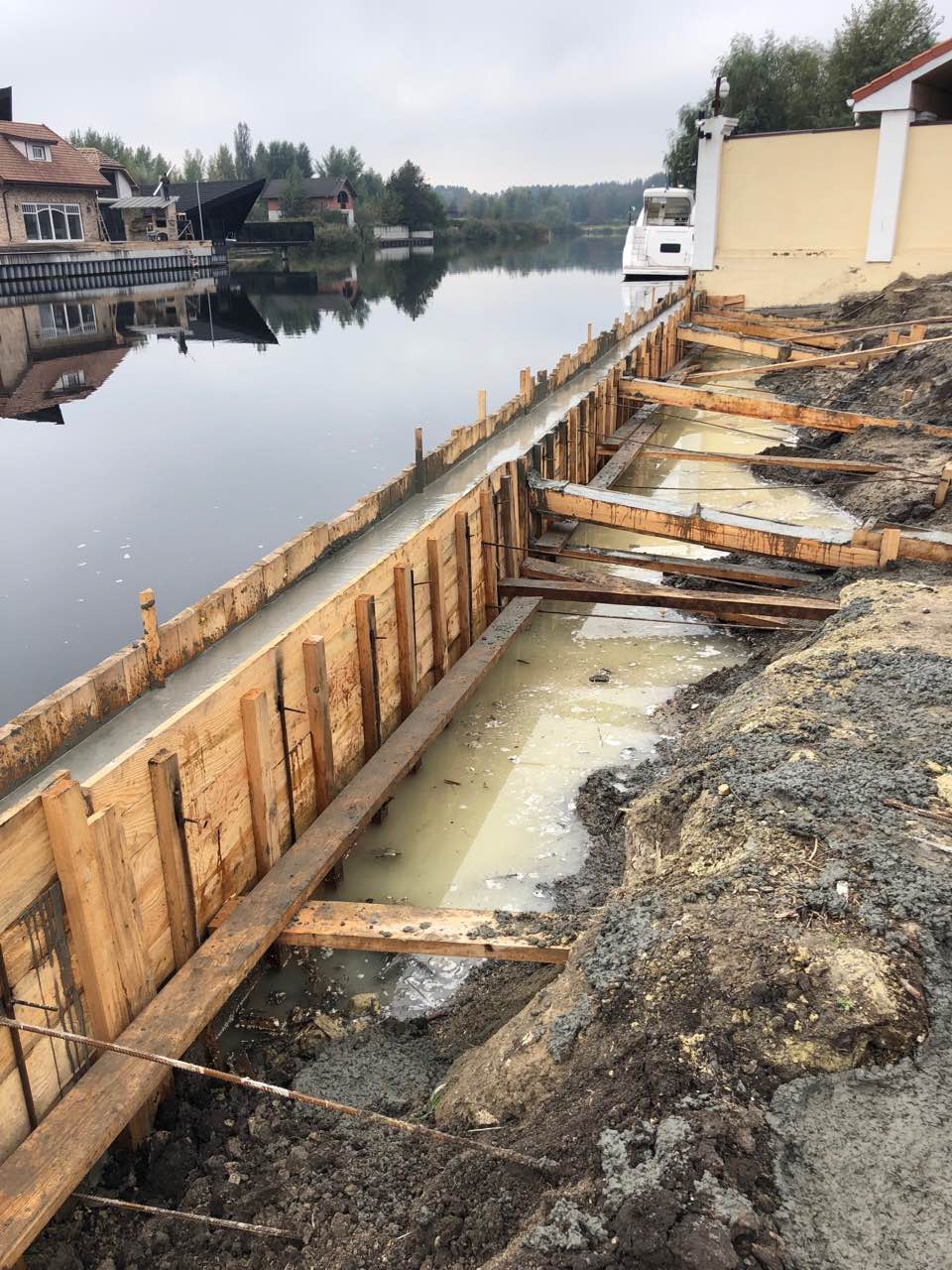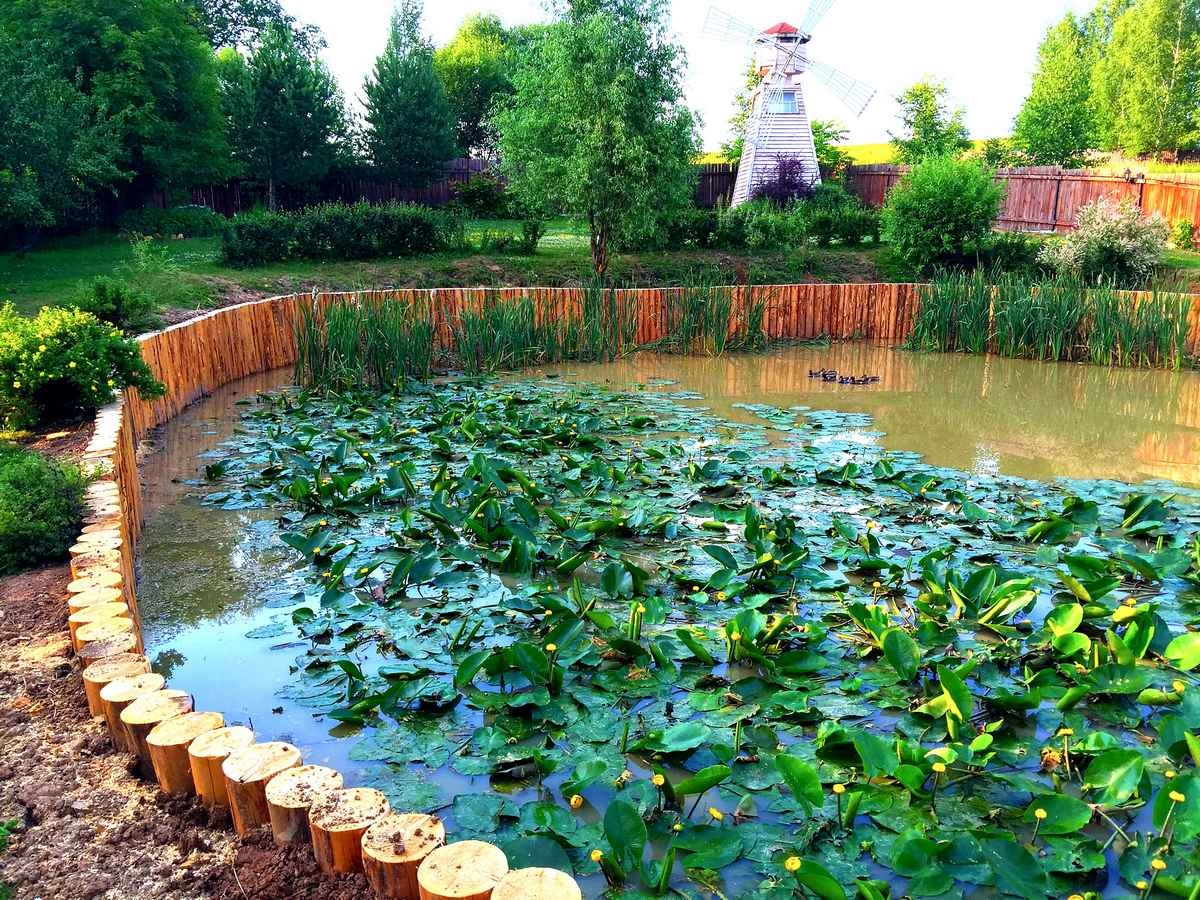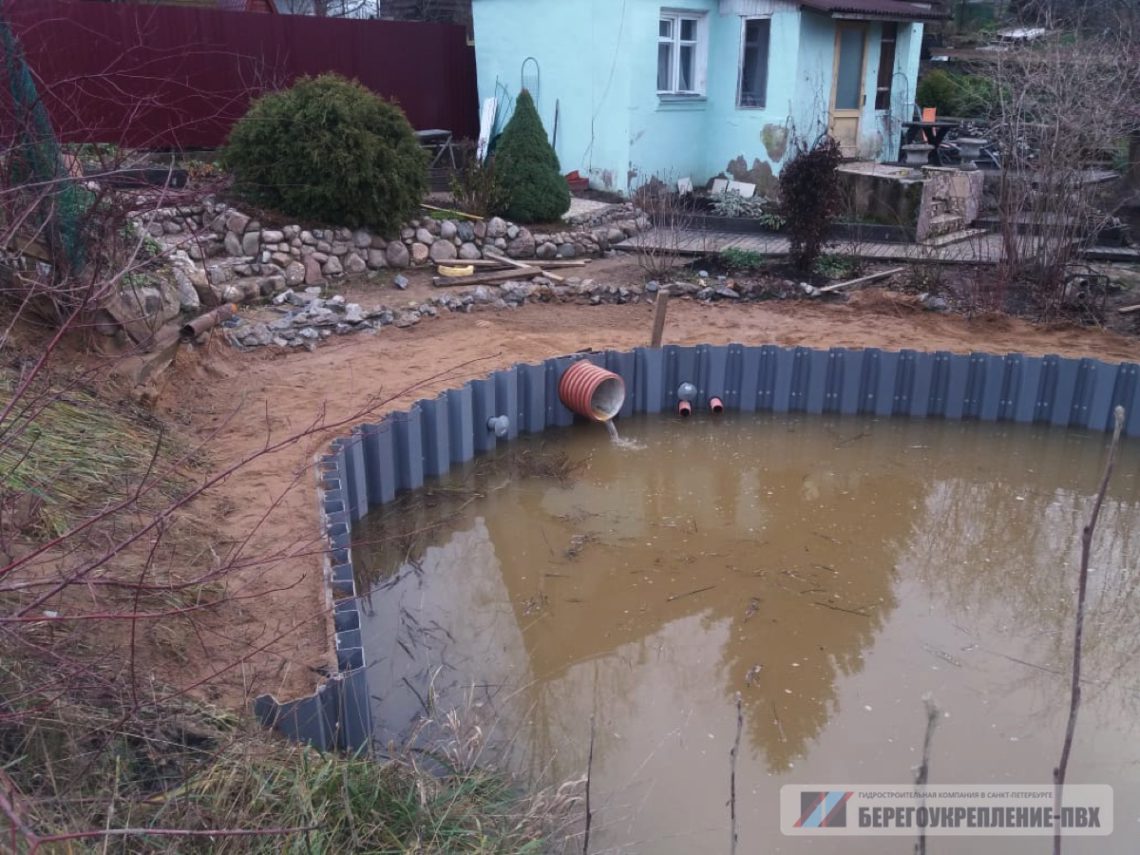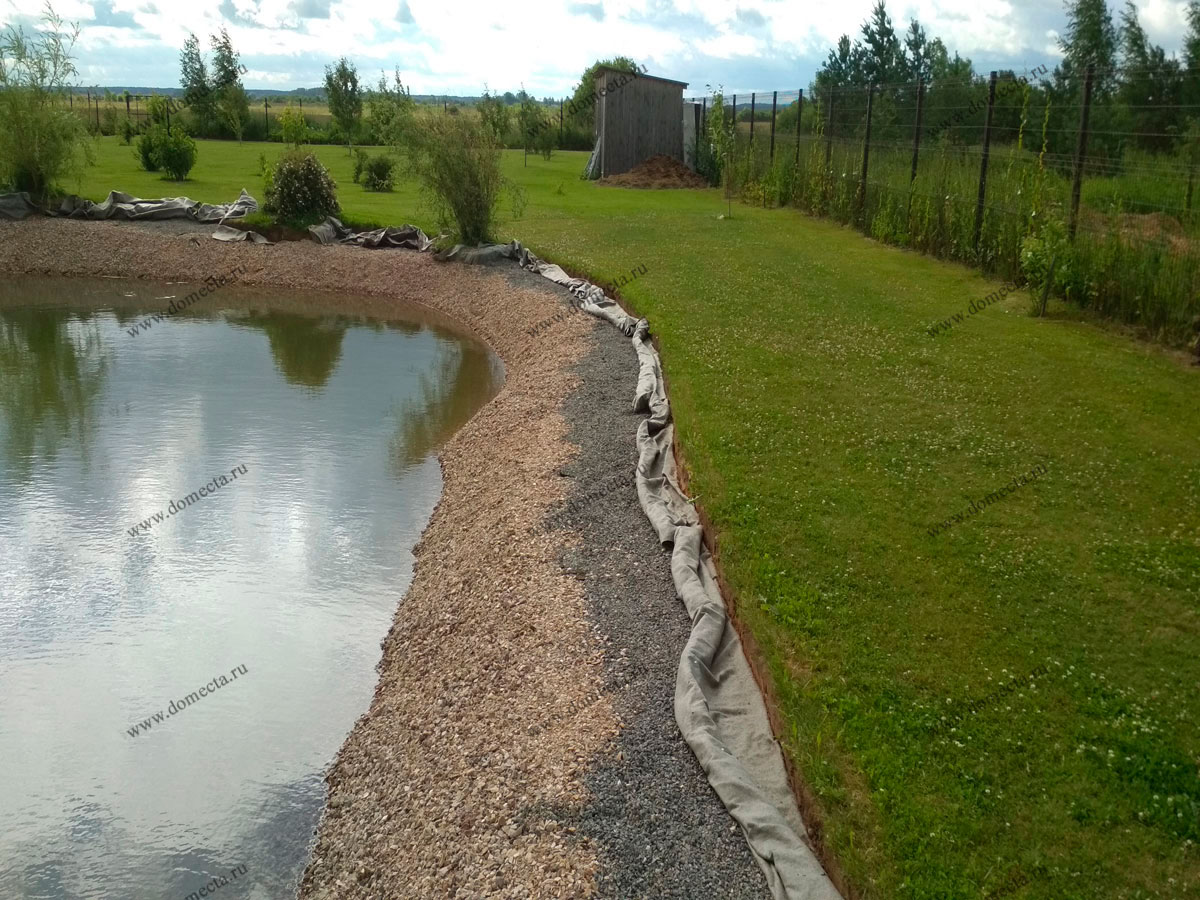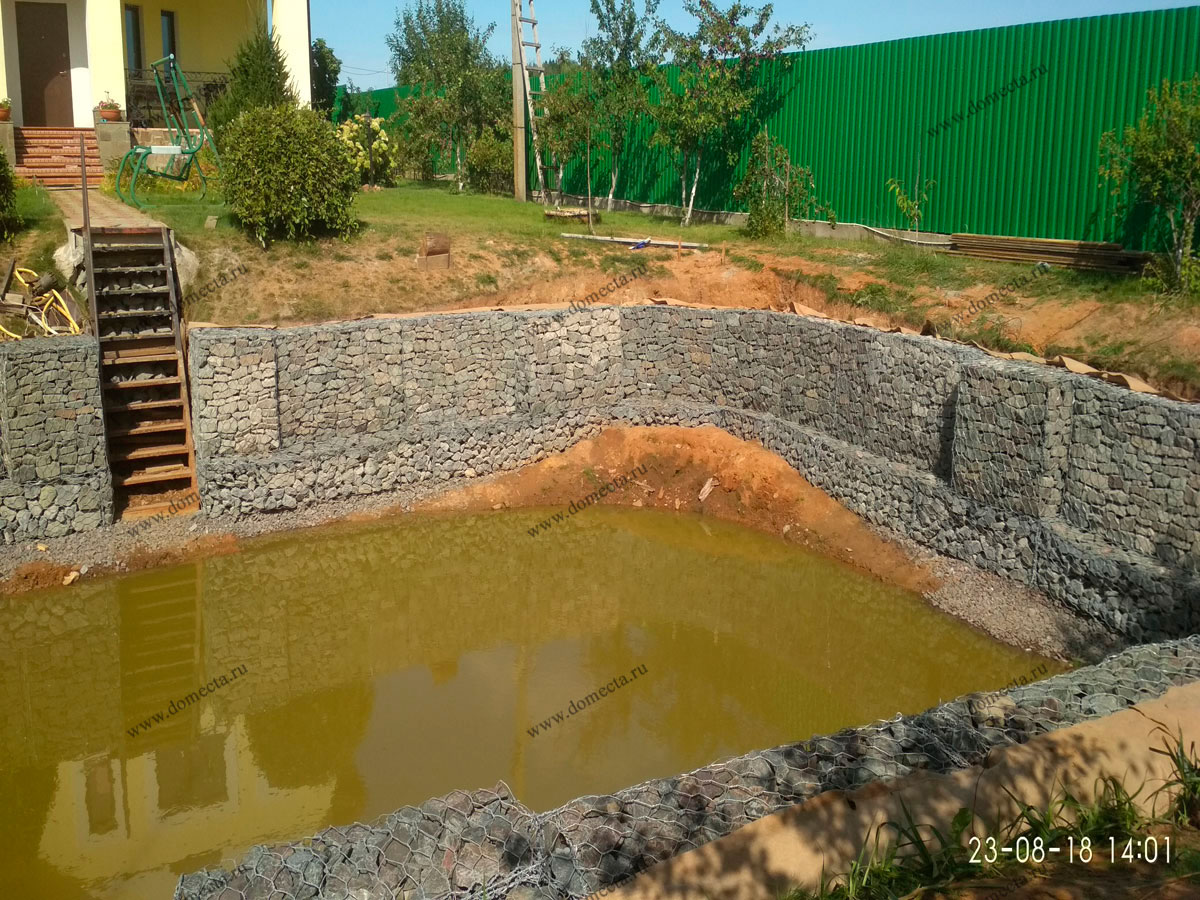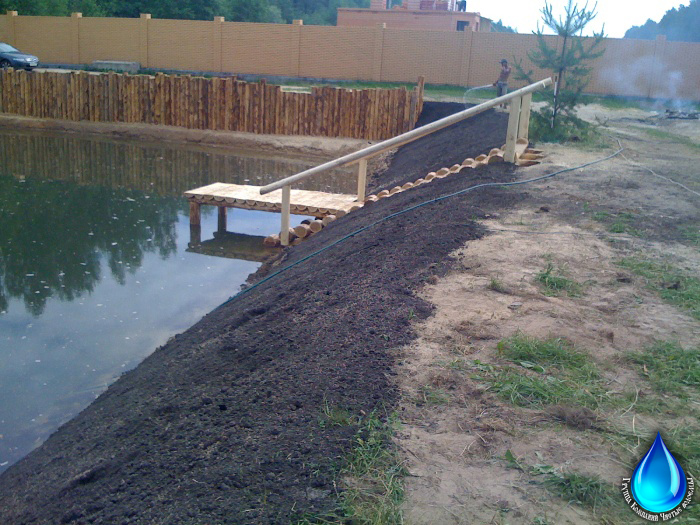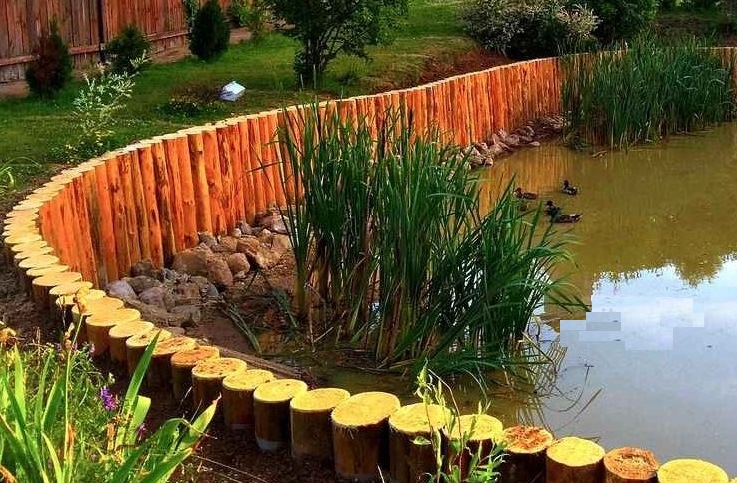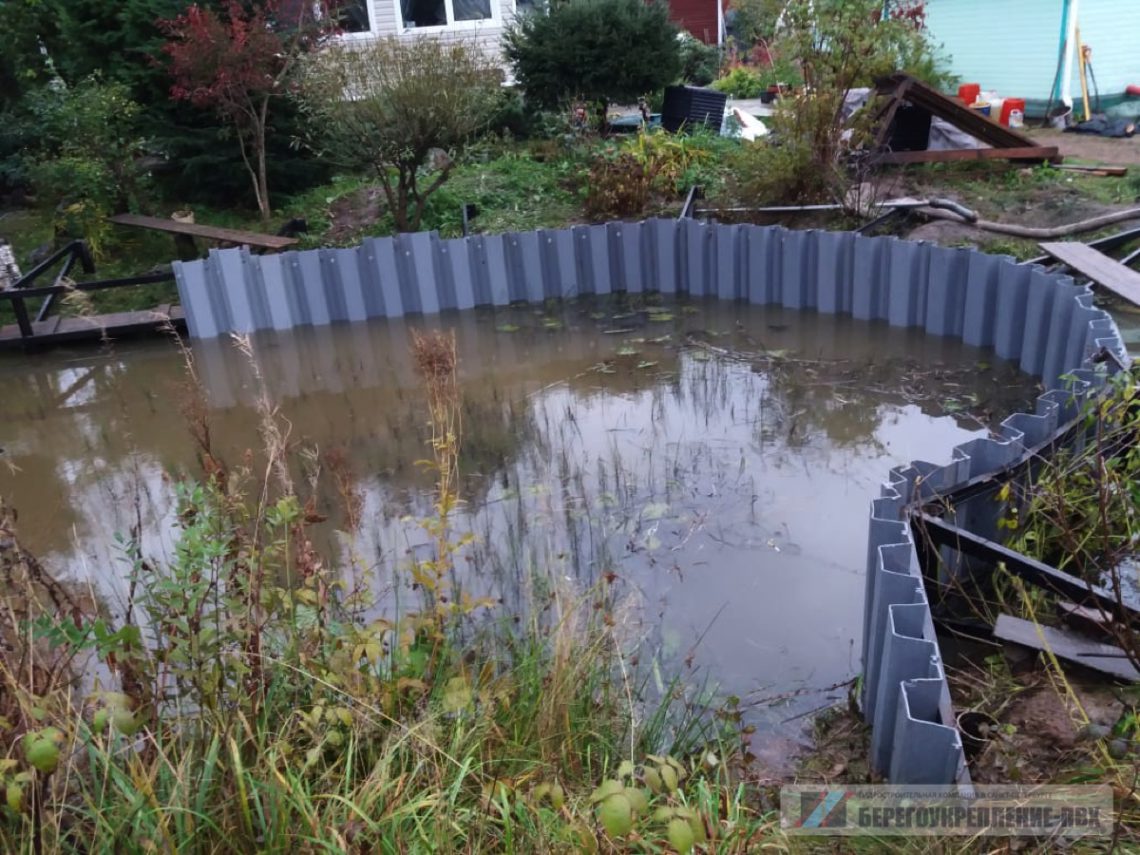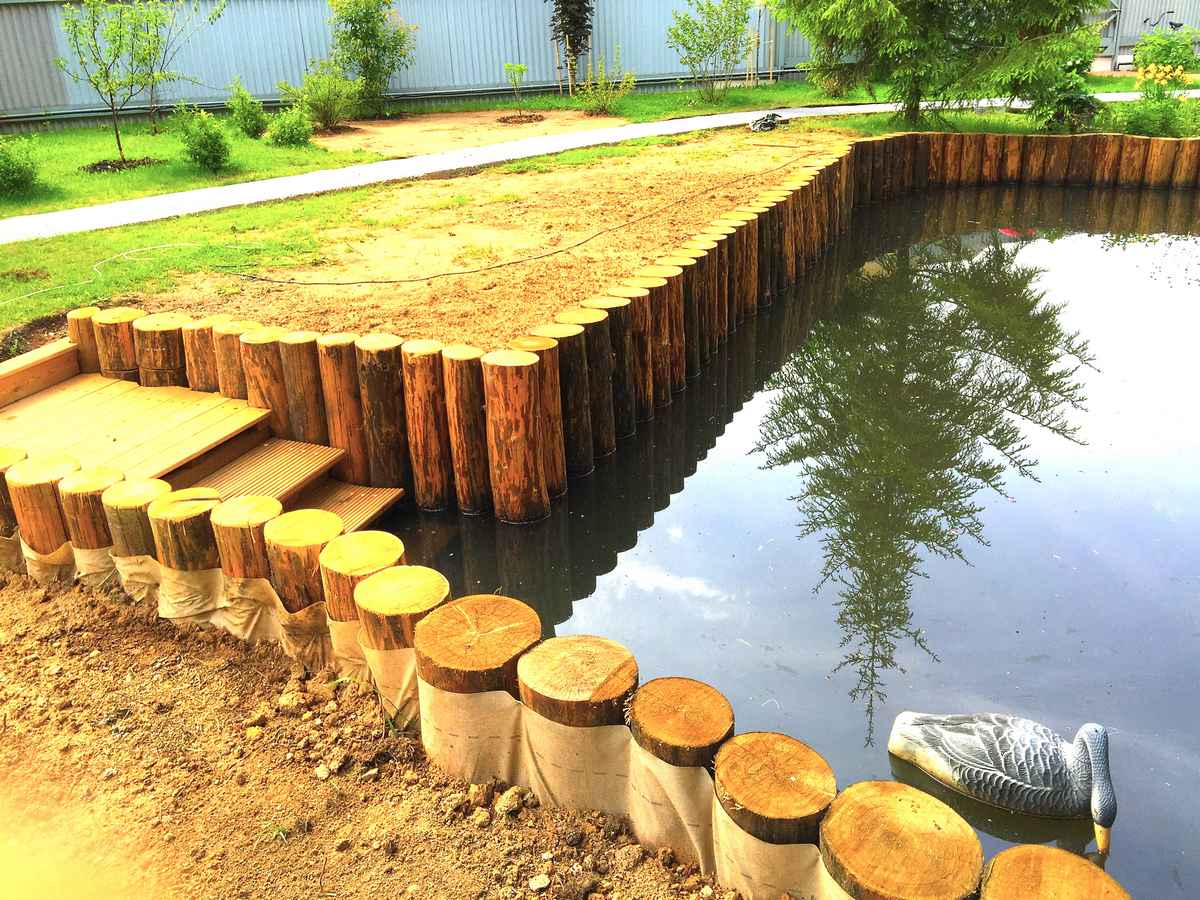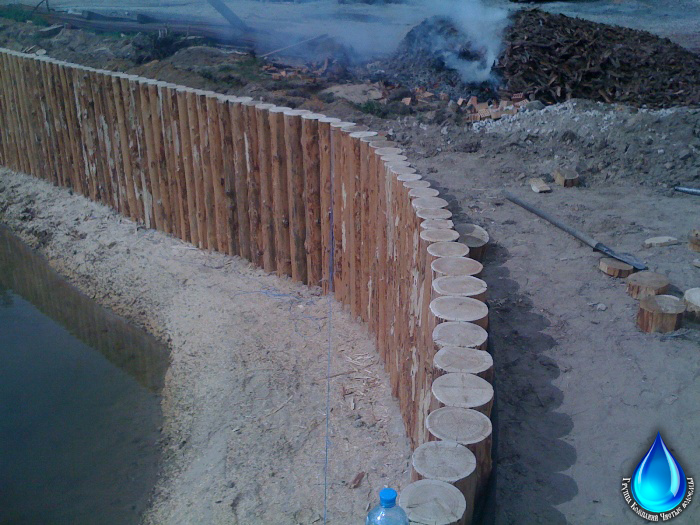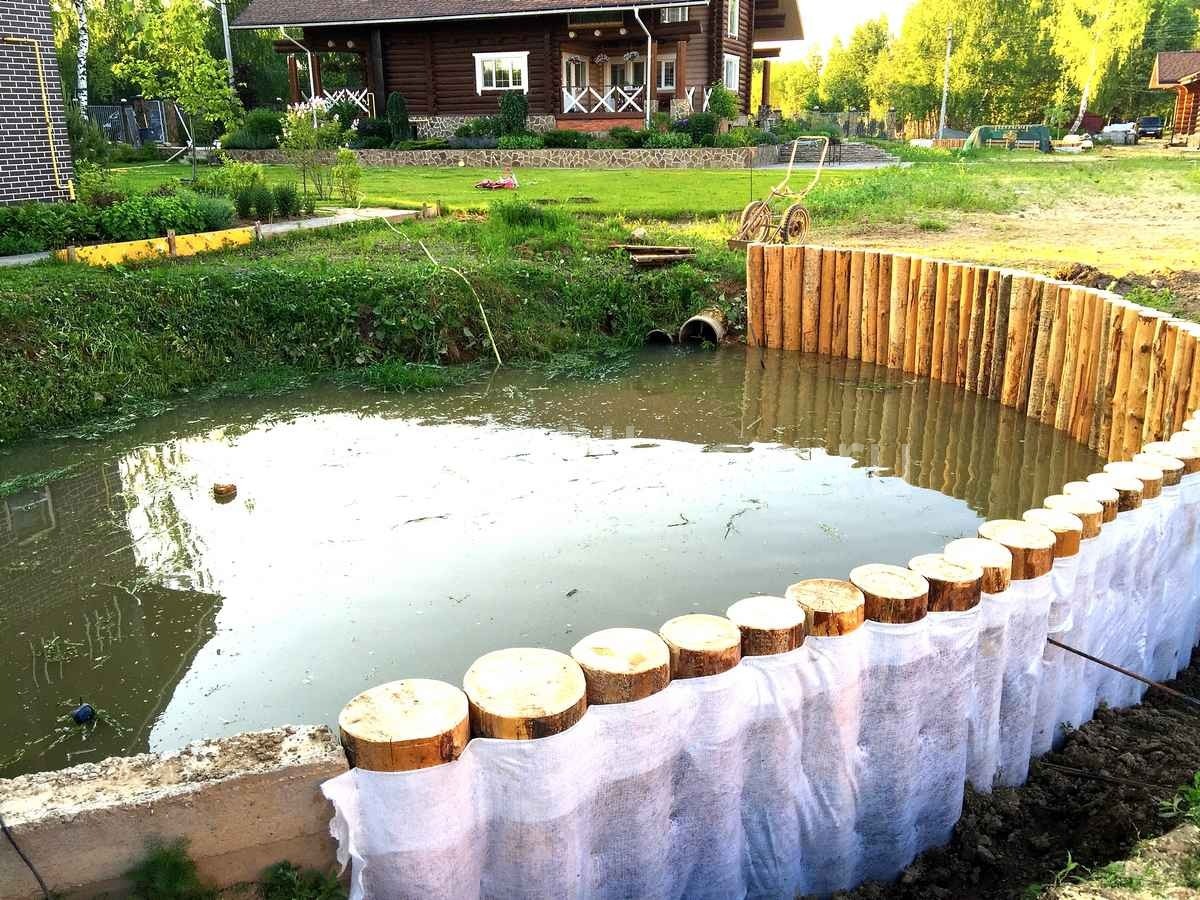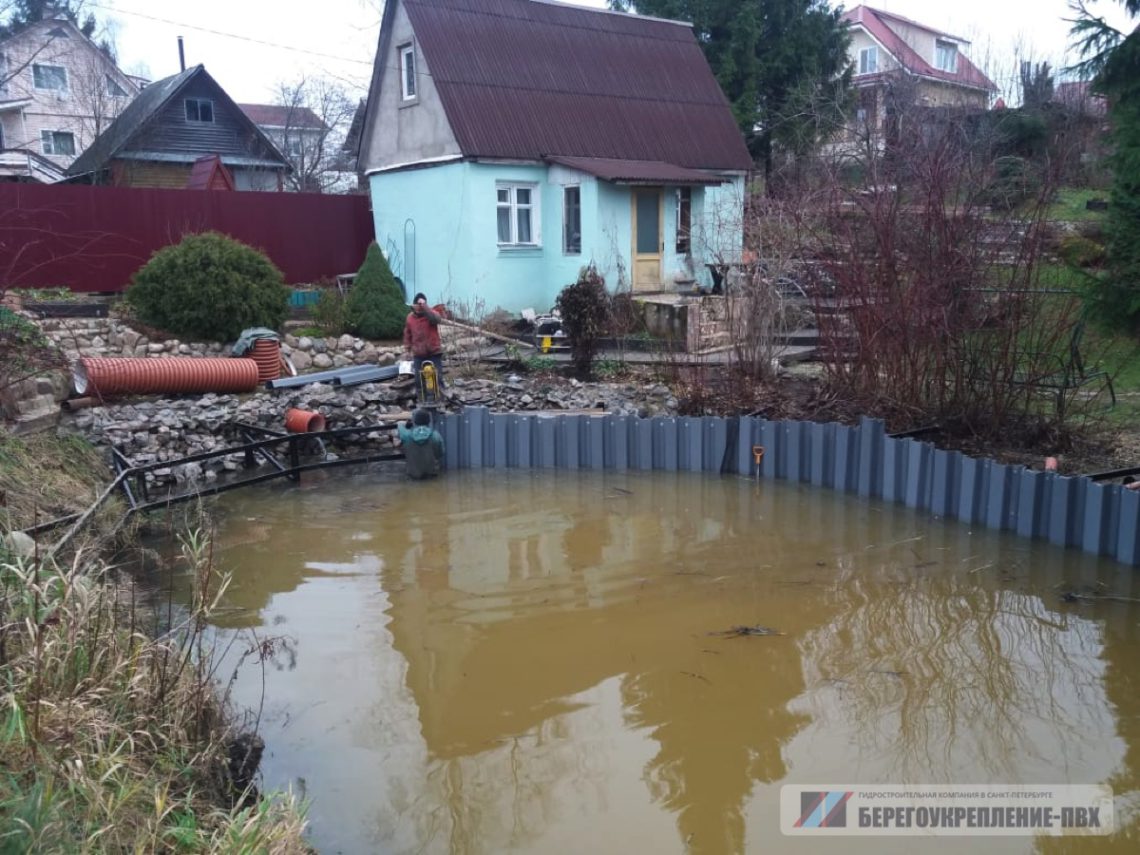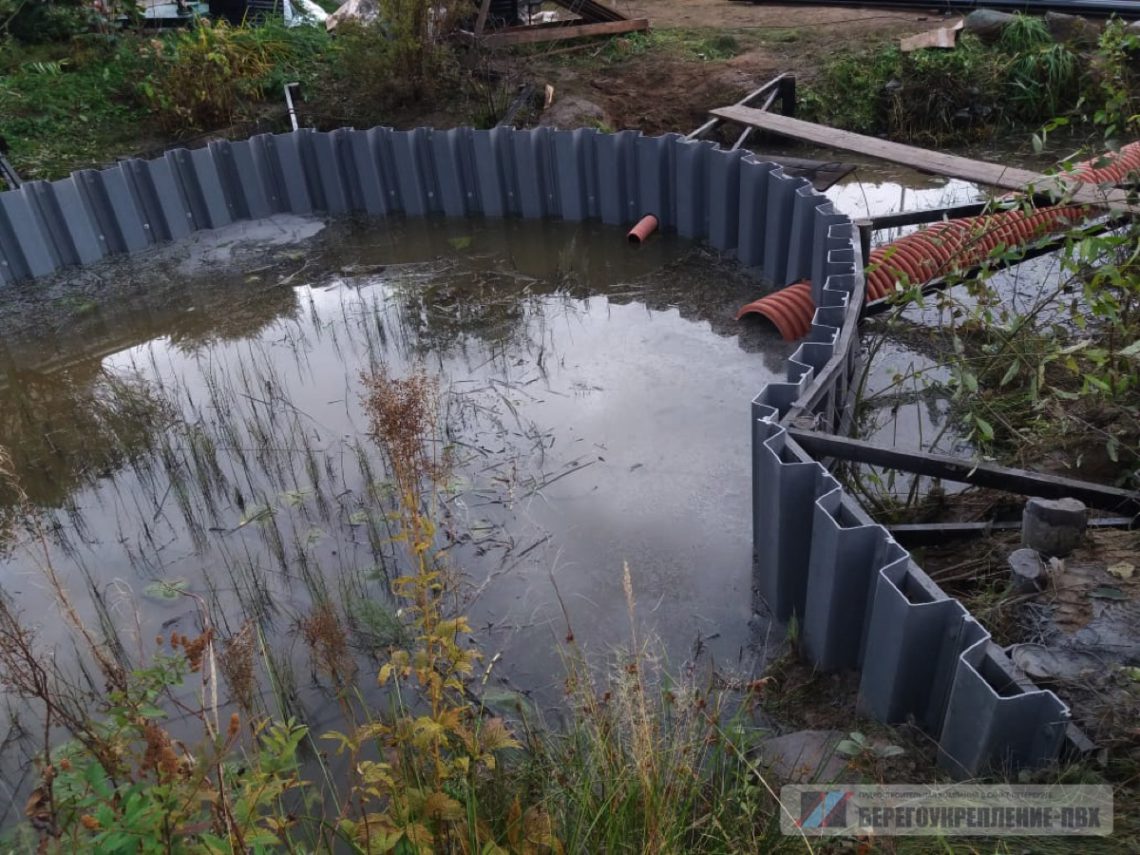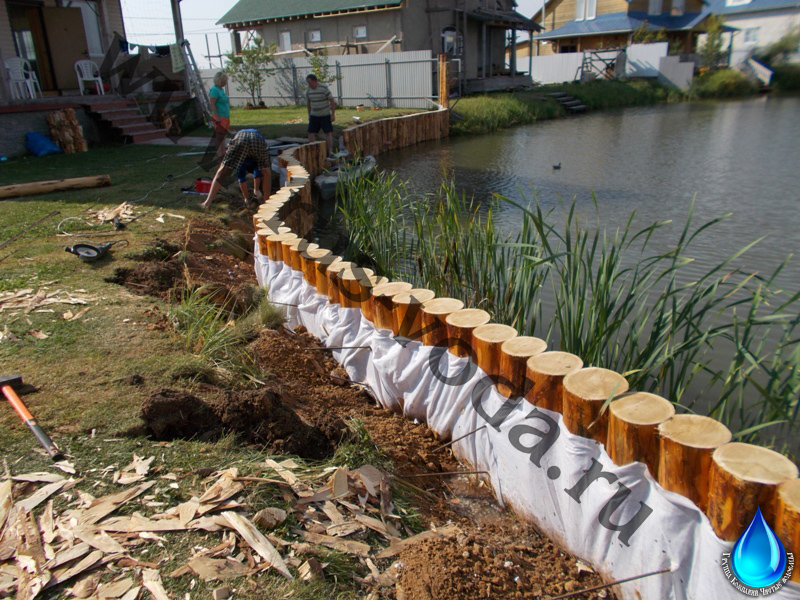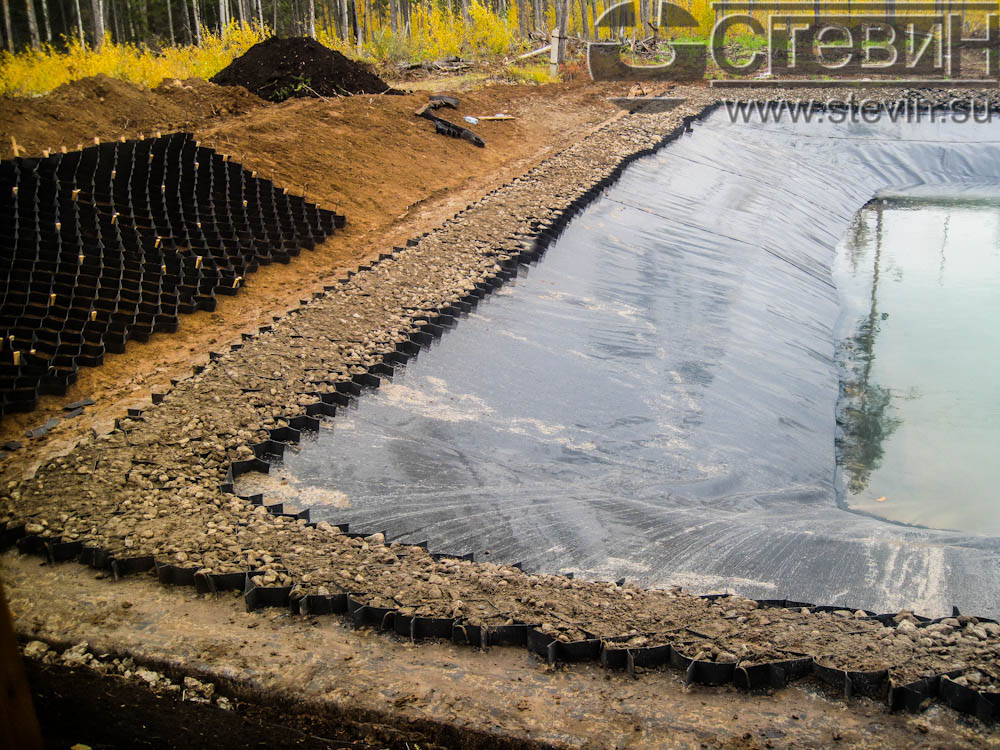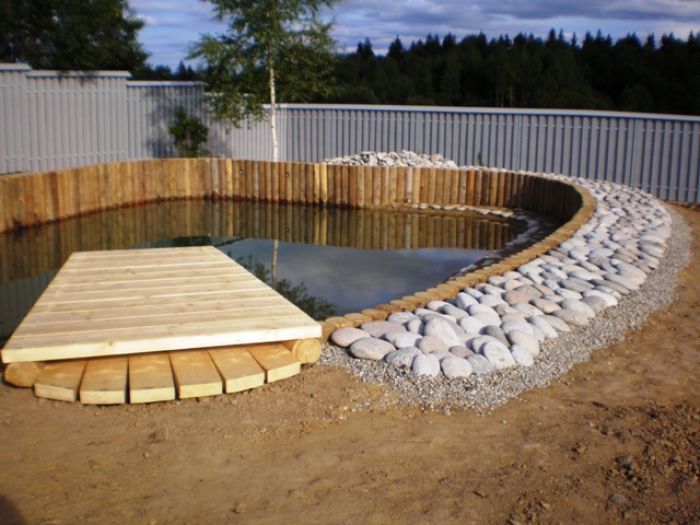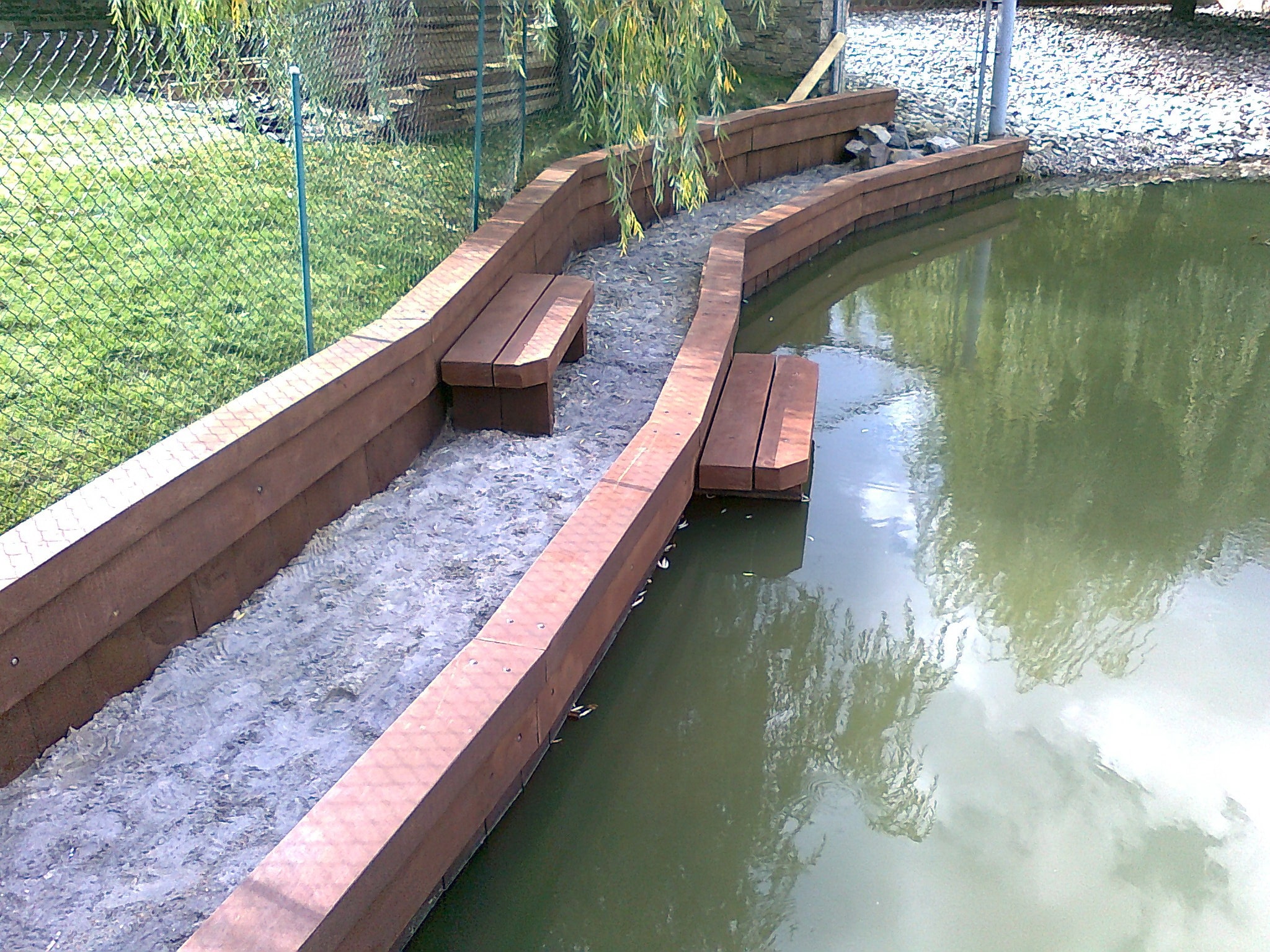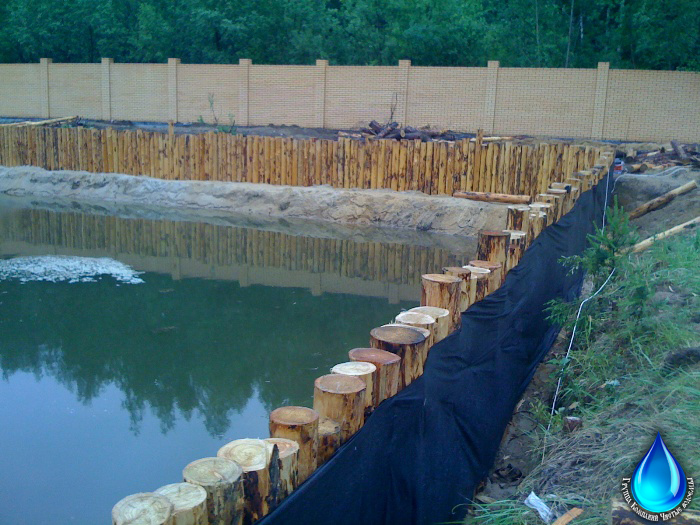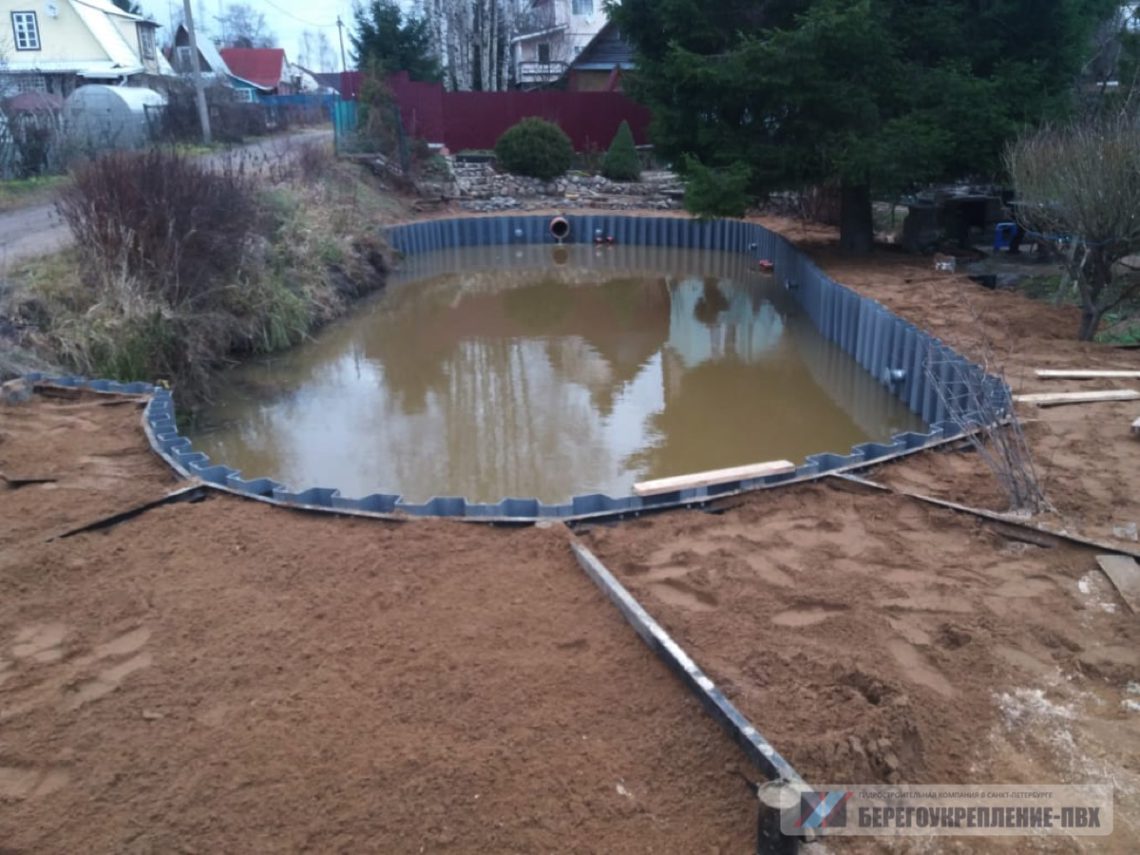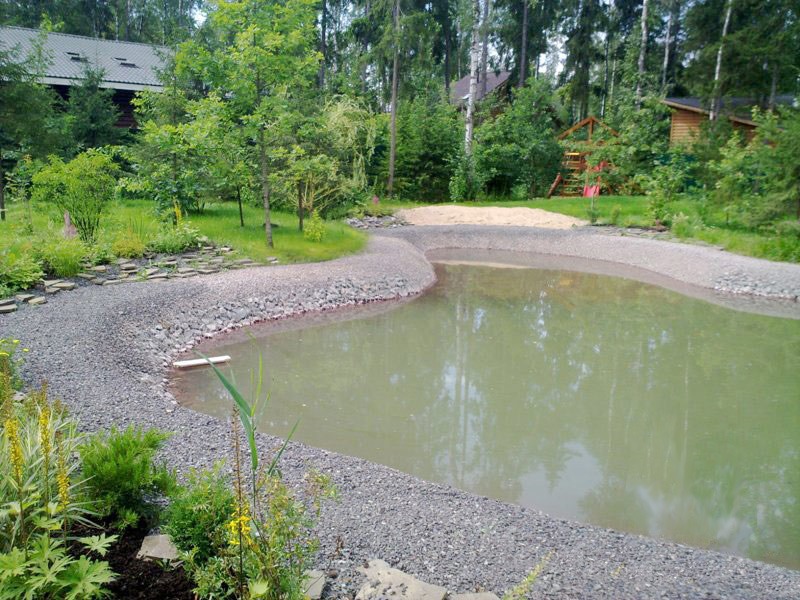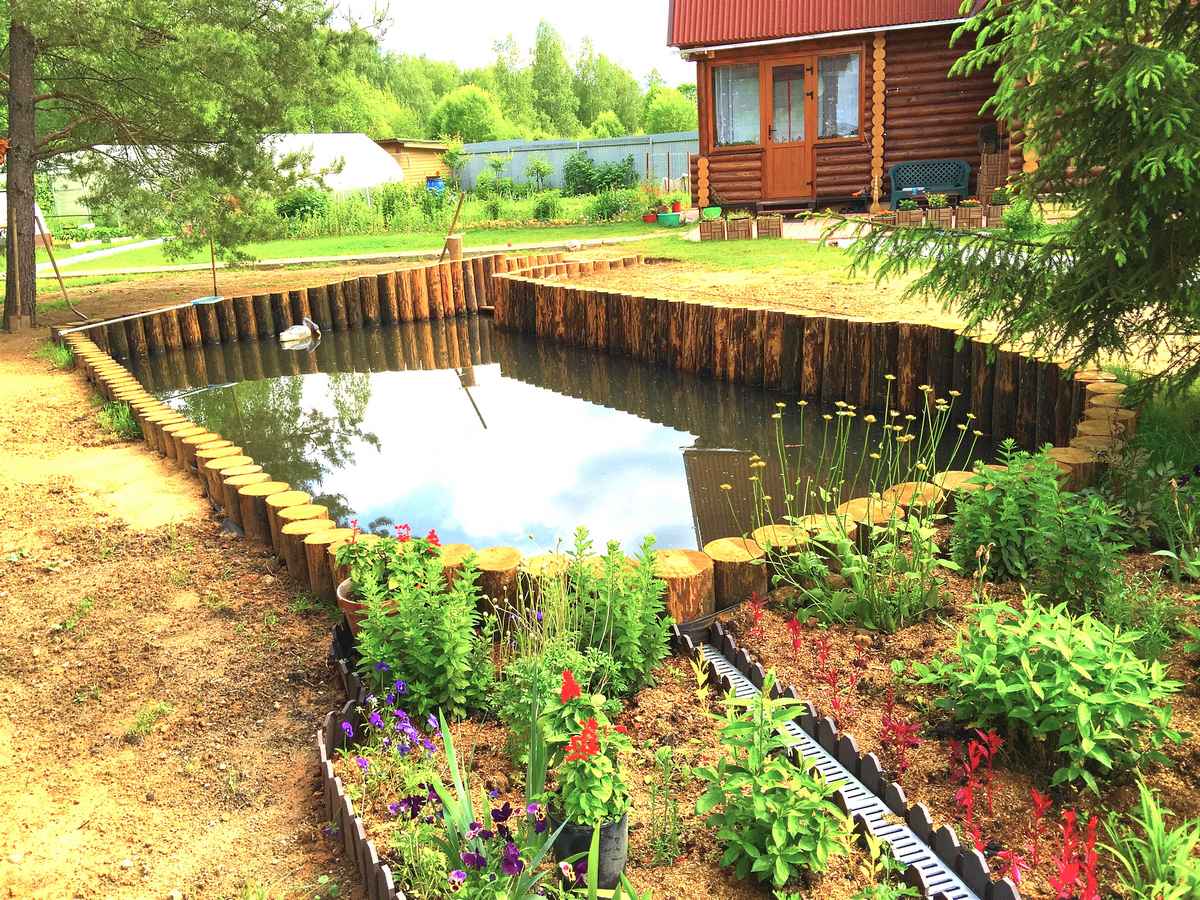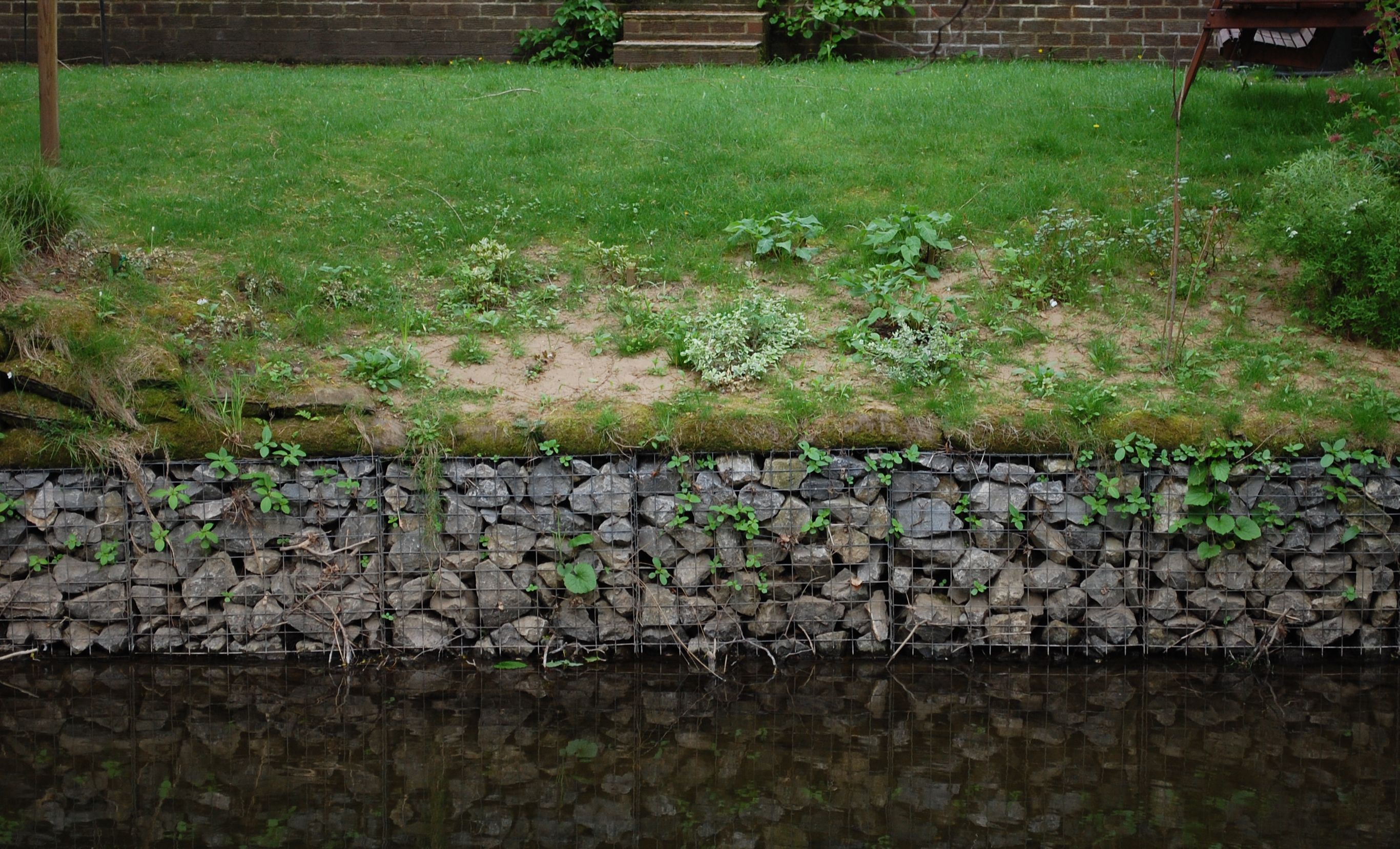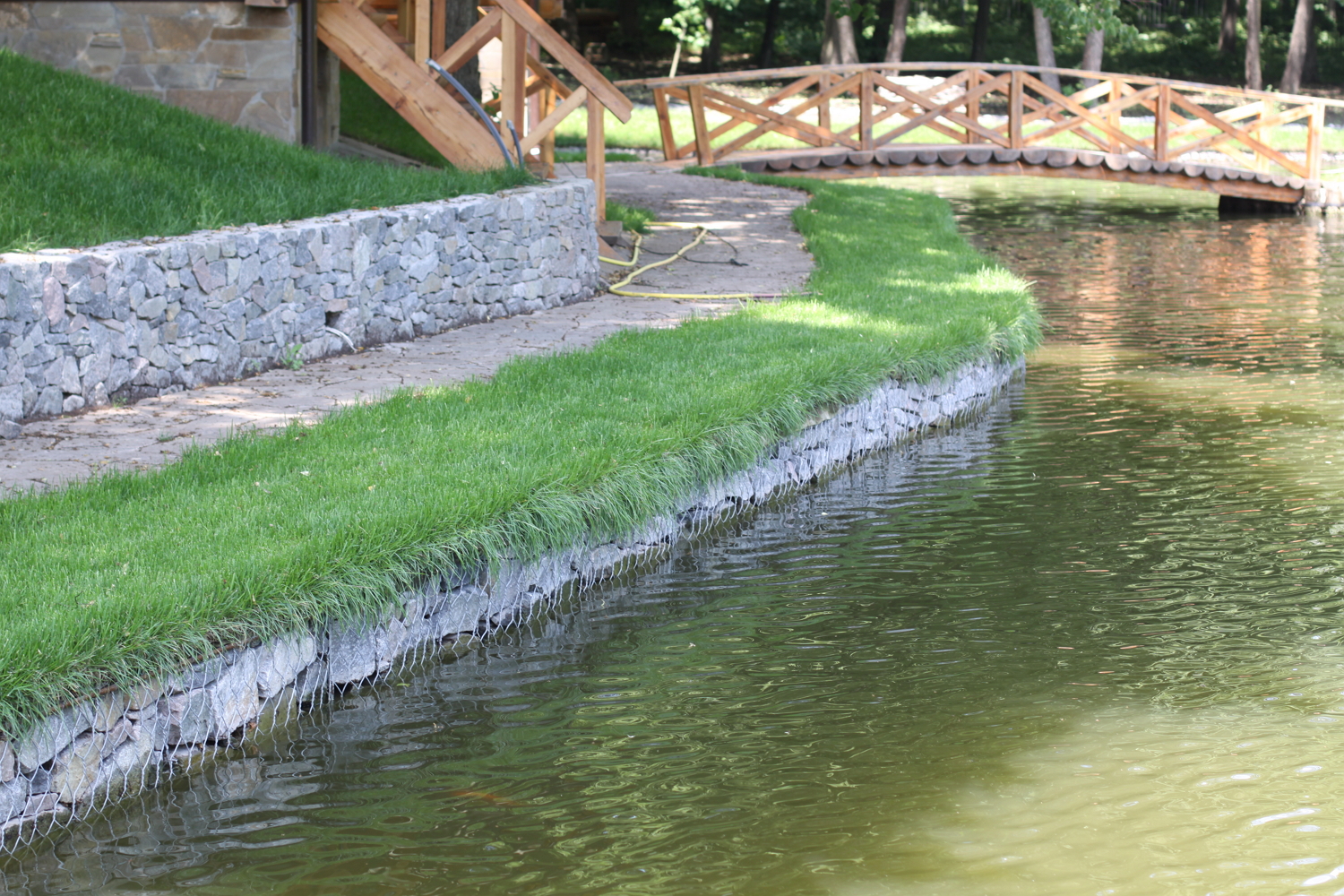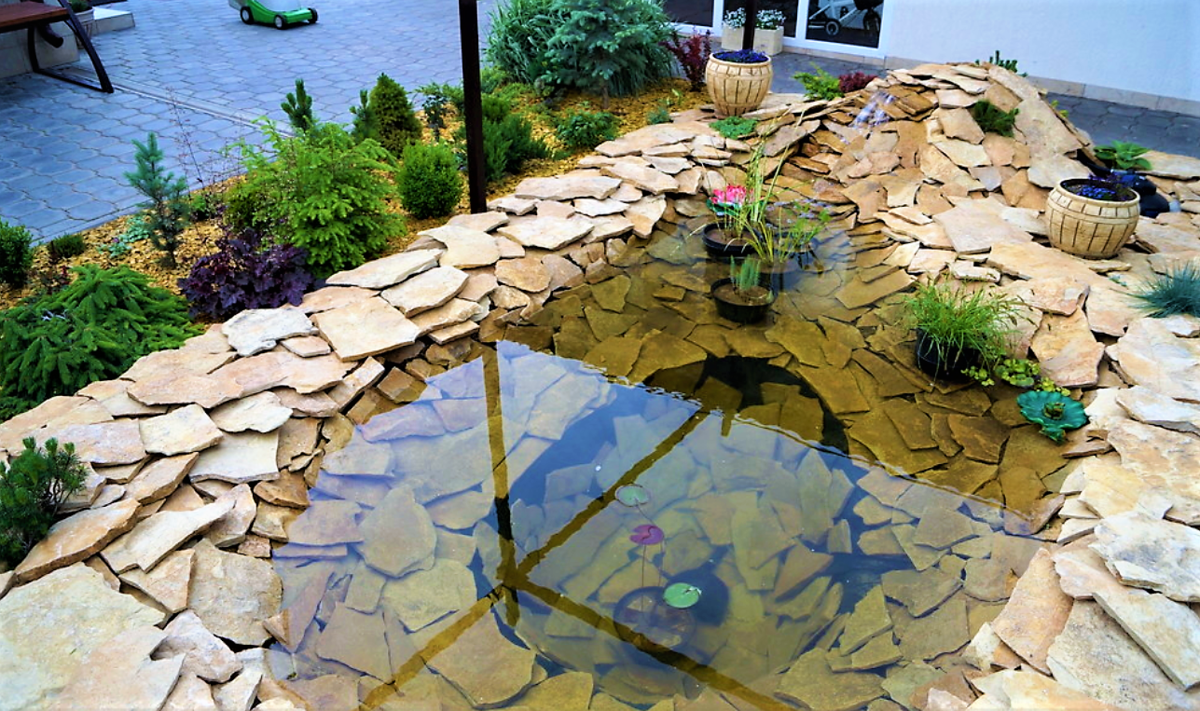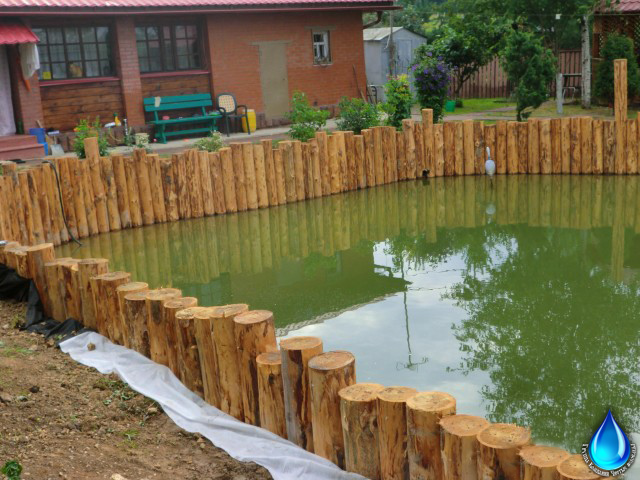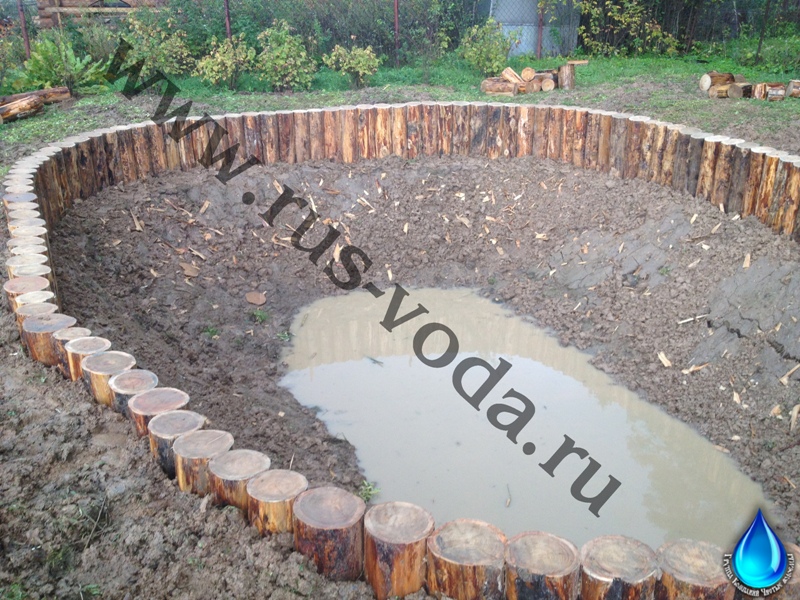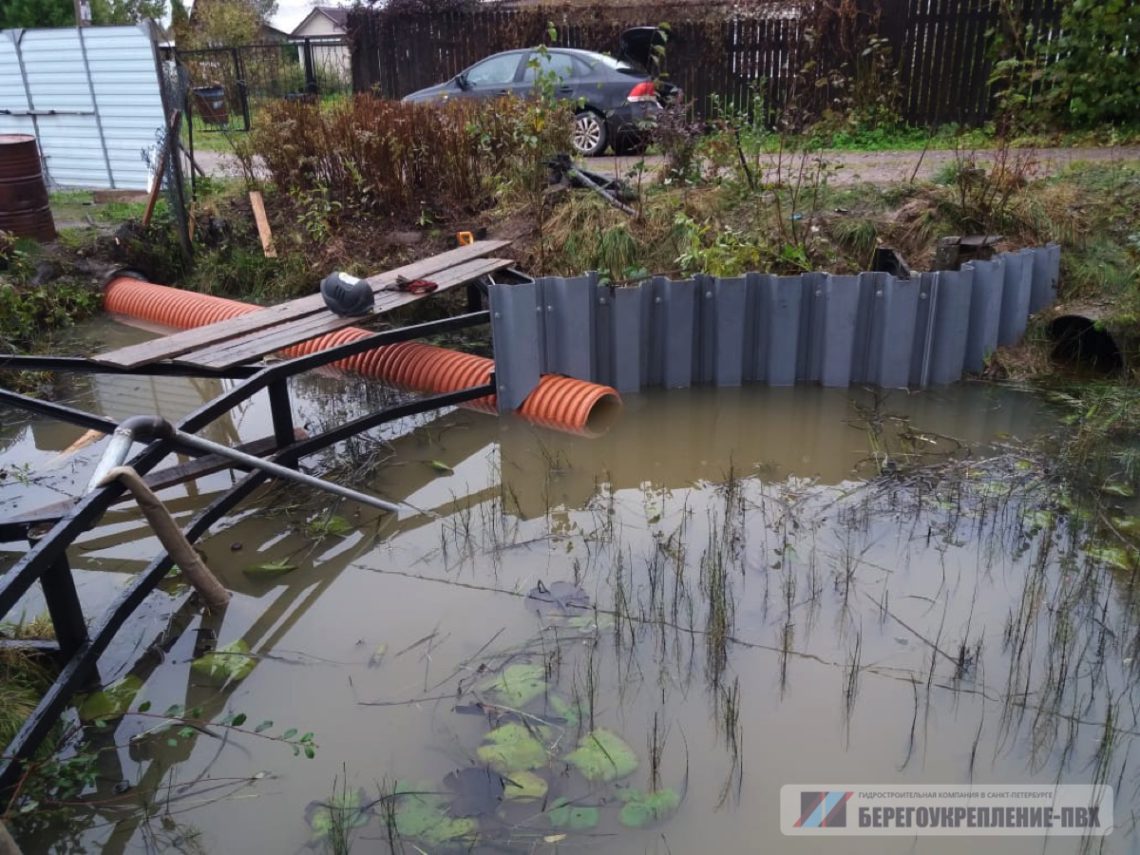Materials for strengthening steep slopes
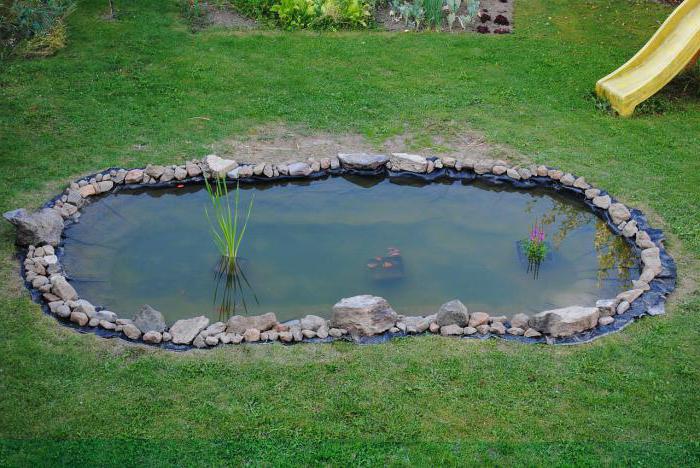
If the shore of the pond on the territory of your site is characterized by a steep slope, then the following materials can be used for strengthening:
- retaining walls;
- wooden piles;
- gabions.
The reservoir on the site will be reliably reinforced in the coastal area if retaining walls are used. Their construction is usually carried out from:
- ready-made blocks;
- stone;
- wood;
- bricks.
This option can completely change the perception of the pond and significantly expand its space. The walls are durable, they resist soil subsidence and erosion. These technologies are relevant if there is a need for vertical planning of the coastline zone. Quite often, the installation of retaining walls is carried out on bases, in the role of which are piles or Renault lattice structures. When the ground is extremely mobile and loose, the height should not be less than one meter.
The reservoir on the site, as mentioned above, can be strengthened in the coastal area with wooden piles. In practice, they are used, despite the fact that reinforced concrete products have the greatest strength. For the manufacture of wooden piles, the most durable types of wood, such as larch and oak, are used. The service life of such structures reaches 50 years.
If a steep bank is decorated with such trunks, then it will look very effective. When using reinforced concrete piles, you can achieve high strength of the fence, but such a system will look dull and gray. Before you can strengthen the shore, you need to choose a technology. The method of use is one of them. These are massive blocks that are filled with stone materials like cobblestones or pebbles. Gabions have a mesh structure, so they are resistant to groundwater and soil mobility. The service life of gabions can reach 80 years, and their strength only increases over the years.
Causes of coastal deformation
Even the earthy banks of a river, lake or artificial pond cannot resist the destructive power of water. Over time, the bottom silts up, the coastline is eroded, and the reservoir itself loses its shape.
The reasons for these phenomena can be:
- instability of the soil, especially sandy and sandy loam;
- congestion of the coastal region with decorative or other structures (sculptures, pumping mechanisms, bridges);
- an increase in the water level due to heavy rains or melting snow mass.

As a result, not only the decorativeness of the reservoir suffers, but the nearest buildings growing near the culture may die and the nearest buildings may be deformed. In this case, the coastline becomes a dangerous area for humans.
Various ways to strengthen the coast
Scheme of strengthening the shore with mattresses.
- It is possible to strengthen the coast with an anti-erosion net. This is a cheap method, as the mesh is a fairly strong but flexible and almost invisible material. Within a month, it is entwined with plant roots and a fortified bank is obtained.
- Coconut mat for strengthening the banks. The material is natural and durable, it is a net of thin interwoven ropes that will support the shore for several years.
- Geogrid for strengthening the banks. Inexpensive, but the most effective option. The geogrid can be laid even on a creeping shore, it will serve you for many years, and the shore will take on a beautiful view. You can easily navigate it even on steep slopes, because it has a mesh texture, so it does not slip.
- Strengthening the coast with a reinforcing mesh.Also a good option, the mesh will not allow slopes to form.
- Biological objects that strengthen the banks. Quite an expensive and short-lived method, because you only need natural elements to strengthen the coast.
- Strengthening the coast with piles. A reliable method in which the bank is strengthened by driving in support piles made of metal or concrete, less often of plastic. Ideal if there are steep cliffs on the shore.
- Sheet piling is the cheapest, fastest method. The tongue is laid out along the coastline and prevents water from washing the ground behind it.
- Plants protecting the shore. A very costly, difficult process, the results of which you will see in a few years. Trees with their roots will create a protective frame that holds back the soil.
- Strengthening the coast with larch. The most reliable and durable way, due to the fact that the tree is quite unpretentious and durable.
- Strengthening the coast with gabions. A flexible, lightweight design that allows you to customize your shoreline.
We considered the main methods and materials for strengthening the coast, now let's move on to how to make such a strengthening with our own hands.
Stage 4. Digging the pit
Step 1. First, we create a sketch of the future reservoir on a scale, indicating the size and width of the curtains (shelves for plants, that is, the upper stage of the structure). This will help to avoid possible difficulties not only during construction, but also when planting plants.
We also think over the accent of the composition - a large original stone, for example, a sculpture or just a tree.
Step 2. With the help of rope or sand we outline the proposed contour of the reservoir. Be sure to check that all the banks are at the same level, after which we use a shovel to cut the turf around the perimeter of the pond.
Making the markup
Step 3. Now let's get down to earthworks. First, we dig a foundation pit to a depth of the first level (about 30-40 cm) and mark a line from which it will deepen to the second mark (90 cm). Next, we create the deepest level (up to 1.8 meters, if we plan to breed fish), we extract the last portion of the soil.
The pit for the pond is formed by characteristic ledges - clumps for planting plants
Step 4. To dig a reservoir, it is advisable to use the services of specialists in this kind of work, accompanied by a small excavator, because this work is quite hard. But if it was decided to do this stage of the work with your own hands, then you should be prepared for the fact that moisture will accumulate in the pit and you will have to dig in a dirty slurry. To remove water, you can use a pump (but only specially designed for pumping liquids with solid particles). Nearby, you can dig another hole to dump water there.
Multilevel artificial reservoir
Step 5. We carefully inspect the bottom of the finished pit for branches, sharp stones and anything that can damage the film. We check the horizontality of the banks, if necessary, level them.
We carefully examine the bottom
Step 6. We dig a ditch 20 cm deep around the perimeter of the pond to fix the film. Then, using a rope, we measure the dimensions to determine the required size of the film, add 0.5 m on each side.
When carrying out earthworks, you can face the problem of where to put the earth from the pit. An excellent solution to this problem is to raise the level of the site by evenly distributing the soil over the entire area of the garden. Another option is also possible - to use the land for the construction of an alpine slide.
Protection of a concrete reservoir
In order for an artificially made pond to serve as long as possible, you need to approach its strengthening in a comprehensive manner. The protection of the reservoir can be:
- technical - involves the use of artificial resources such as geogrids, gabions, and so on;
- biological - planting the territory with plants that slow down erosion, for example, larch, reed and others.
Special materials give the desired effect immediately after installation. Plants take time to grow roots, but they look more natural.
To strengthen a concrete reservoir, the following are suitable:
- The special mesh is lightweight, durable and flexible. The geomat is filled with plant soil components, the roots strengthen the soil. It turns out a reinforced zone.
- Geogrid - the method is identical to the previous one. Pebbles are used as the main material.
- Coconut mat - formed from intertwined ropes with a fibrous structure.
- Gabions are box-type retaining walls, used when the previous options are ineffective. In addition to reliability, they perfectly complement the design of the site.
The above methods are quite effective, they last much longer than green spaces. If desired, you can decorate the materials, carefully hiding their gray building appearance.
How to strengthen the banks of the pond in the country with your own hands
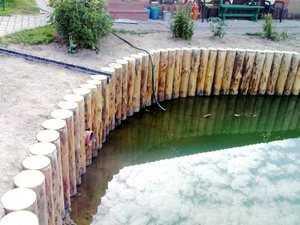 An artificial reservoir pleasantly diversifies the landscape, but if mistakes were made during the construction, then the banks will begin to crumble after a while. The soil “creeps”, the pond is silted up, a film is visible along the edges, which is lined with a reservoir, or an ugly concrete base. It is better to immediately strengthen the banks of the pond at the dacha in order to decorate them without fear of erosion. When choosing a method, you need to take into account the size of the reservoir, the features of use and your financial capabilities.
An artificial reservoir pleasantly diversifies the landscape, but if mistakes were made during the construction, then the banks will begin to crumble after a while. The soil “creeps”, the pond is silted up, a film is visible along the edges, which is lined with a reservoir, or an ugly concrete base. It is better to immediately strengthen the banks of the pond at the dacha in order to decorate them without fear of erosion. When choosing a method, you need to take into account the size of the reservoir, the features of use and your financial capabilities.
The most popular methods for doing work on your own
The most famous technical methods of protecting the reservoir from shedding are gabions and geogrids. Both methods are based on the use of a mesh structure that protects the walls and banks of the reservoir from shedding.
Geogrid installation features
To strengthen the pond with your own hands in this simple way, you will need:
- geogrid with a suitable mesh size;
- drainage geotextiles;
- anchors for fastening and pneumatic stapler;
- shovel;
- filler.
The top layer of soil is removed, drainage is laid, and a geogrid is placed on it. Separate sections are fastened together. The cells are filled with crushed stone, frost-resistant concrete, soil or other material. If plants are planted in the soil filling the cells, then their roots will additionally strengthen the shore.
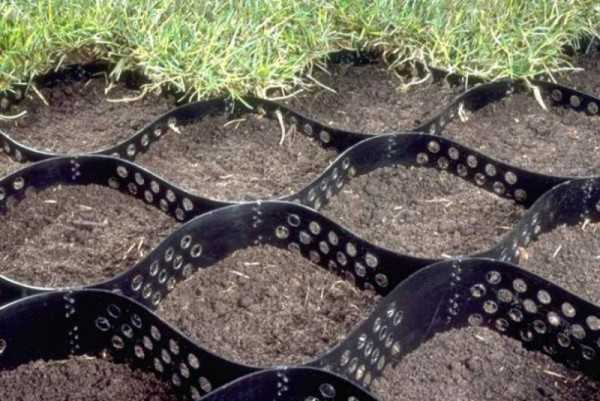
The choice of filler for mesh cells - a matter of taste
Gabion structures for decoration and strengthening
Gabions are one of the most reliable methods for strengthening banks and walls. Wire boxes, fastened to each other, are installed along the edge of the reservoir. The corners are fixed. With the help of gabions, you can build retaining structures along the coast.
Densely filled with crushed stone, exceeding the size of the holes of the cells, gabions serve not only to strengthen, but also to decorate the reservoir. The porous structure allows no additional drainage. Over time, this structure becomes even stronger due to filling with soil and growth of plants.
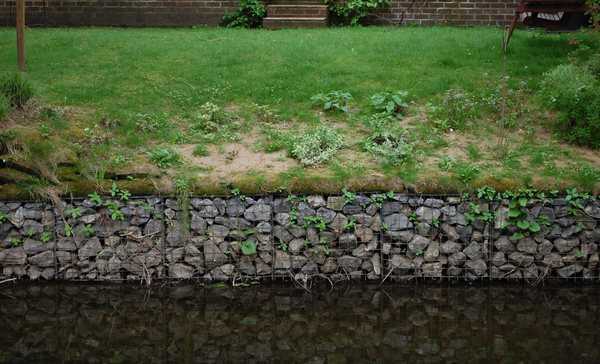
Gabion designs for shore decoration
Biomats and plants - caring for the environment
How to strengthen the pond in the country, so as not to disturb the existing landscape, to give the reservoir a natural charm? The most environmentally friendly method is to strengthen the pond bank using the root system of plants planted along the coastal zone. However, it is quite difficult to independently select specimens that will keep shedding. It will take time for the plantings to grow, but there is a risk that they will not take root. Suitable for the middle lane:
- weeping willow;
- sea buckthorn;
- Red currant;
- sedge;
- swamp iris;
- cattail and other species;
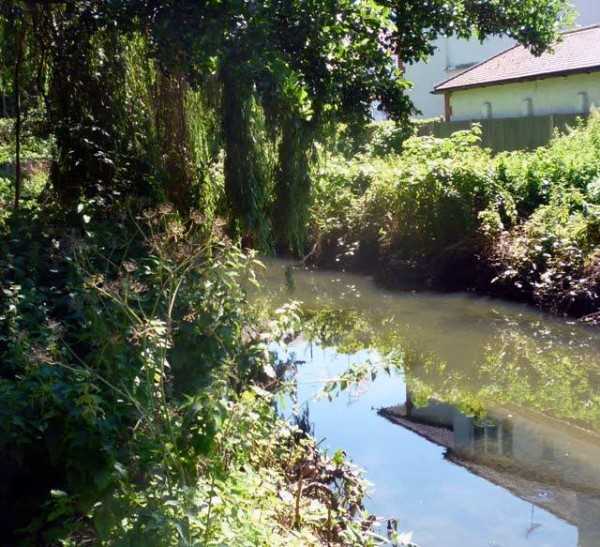
Plants help make the body of water a natural part of the landscape
With the help of coconut mats, the strengthening of the pond at the dacha is performed even with high steepness of the slopes (up to 60%). The slope is leveled, natural fiber mats are laid on it with an overlap of 20 cm.They are attached to the pond film with waterproof assembly glue. Then a thin layer of soil is poured and the lawn is sown.
Large stones and boulders look very attractive, with which you can lay out a fence near the water after installing a geogrid or biomat.
Making a steep bank with piles
Piles are the oldest way to strengthen water bodies. Traditionally, piles were made of wood, but strengthening the shore of a pond with your own hands using wood is not as easy as it seems at first glance. Hardwood piles look impressive, but they require special equipment to drive them. Another "minus" - over time, the tree may darken. Special impregnations help, but are not a panacea.
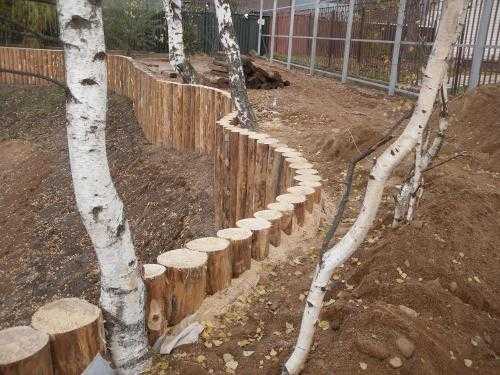
Wooden piles for strengthening the bank
PVC piles are a modern alternative to wood, they will last for decades, but special equipment is also needed for their installation. For a small reservoir, using the pile method is not very convenient.
The pond will retain its original appearance for a long time, if you think about strengthening it at the excavation stage. To do this, the work should be supervised by a professional who will assess the steepness of the slope, the size of the reservoir, the characteristics of the soil and will tell you which type of reinforcement to choose.
After consulting with specialists, you will learn how to strengthen the pond in the country with your own hands or, having evaluated your strengths, you can order all the work on a turnkey basis.
Capital bank protection
To minimize the likelihood of damage to the coastal strip from the destructive effects of water, capital bank protection allows. This group of bank protection works includes technologies based on the use of gabions, geomats, sheet piles, hydraulic concrete grades, and special volumetric reinforced concrete structures.
Gabions are nets made of double-twisted galvanized wire, which are laid out in boxes at the installation site, filled by hand with large natural stone. For reliable fastening of individual structures to the ground, special anchors are used. The boxes are twisted together with wire. After partial filling of the gabion with stone backfill, so-called "braces" are installed, which do not allow the opposite walls of the box to "diverge" to the sides.
The banks of reservoirs, fortified with gabion structures, do not erode or float. For many years, the contour of the coastline, which was set during the bank protection works, has been preserved. This technology, which has been used for a long time in Europe, has found application in Russia as well. You can see gabion structures on ponds, rivers, bypass canals and other bodies of water.
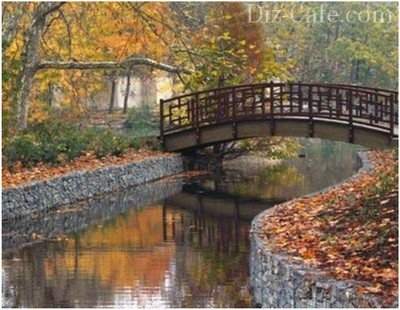
The coastline of the river is neatly framed by gabion structures with a strict geometric shape. Natural stone in mesh boxes is in perfect harmony with the autumn forest
Sheet piles made on the basis of PVC and composite materials make it possible to strengthen the coastline in the shortest possible time. This method of bank protection is considered low-cost. Most of all, PVC sheet piling is suitable for the arrangement of steep banks. One of the advantages of this material is its recyclability. During installation, the individual sheet piles are lined up into a solid, dense wall. A reliable connection of adjacent elements is ensured by a longitudinal rib projection present on each sheet pile. The immersion of single or double PVC sheet piles is carried out using autonomous hydraulic equipment, selected taking into account the soil conditions.

Schematic representation of the installation of sheet piles made of PVC materials to strengthen the steep bank of an artificial or natural reservoir
How to strengthen the edges of a natural pond in a summer cottage? - expert answers.
Long dreamed of a pond in the yard, and now my dream has come true. Joy knew no bounds !!! But there was a problem with water purification.Water quickly starts to fill up, and disappointment sets in, which I never expected. Nymphees grow in my pond, and ...
The water surface glistens, dragonflies flutter, water lilies and lilies delight the eye - beauty, and nothing more! Water in the garden is needed not only for irrigation - this is one of the axioms of landscape design. Simple little ponds, graceful garden fountains or ...
At first, creating a small reservoir on your site may seem like a rather difficult task. Of course, this is not easy, especially when it comes to large reservoirs made of stone, cement, multi-level, with fountains, etc. It still depends on ...
A terrace with a pond for Barbara and Rüdiger Elger has long been just a secret dream. But finally, the couple decided to bring their idea to life. Now goldfish live in their pond ... 1. A pit for the future reservoir of the wife ...
Ooze started up in my dacha pond. How to get rid of it?
I decided to take part in the competition for summer cottage master classes. Maybe someone will find my little experience useful! Of course, I am not a professional, but now, thanks to the Internet, you can learn a lot, there would be a desire! I had such a desire not ...
What it is
Bank protection is a complex of special measures that are aimed at protecting the banks of an artificial or natural water source. People who own houses, summer cottages or other structures near the reservoir think about how to strengthen the territory and prevent negative consequences from the influence of water. Strengthening by hydraulic structures is necessary to protect the coastal line from erosion, collapse, undermining, erosion from flood or storm water, subsidence of the soil.
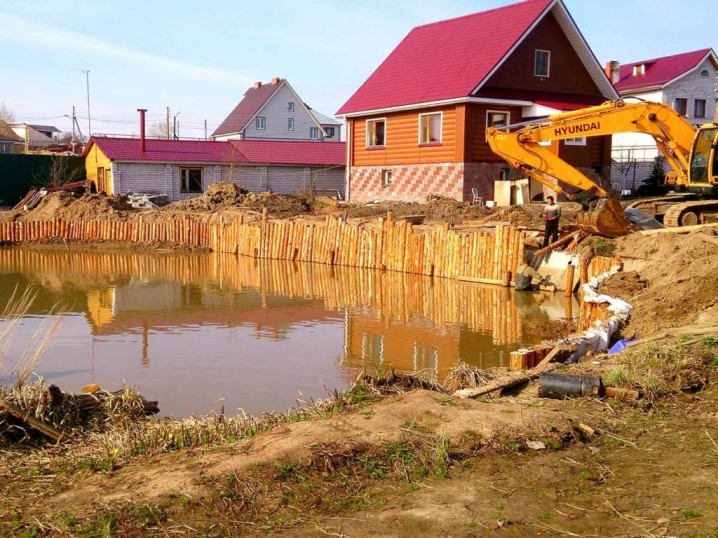
The erosion and subsidence of the coast is one of the reasons for the shallowing and overgrowing of not only the water source itself, but the area around it. Structures erected in this zone are threatened with destruction, therefore, there are currently measures that protect the coastline and prevent all negative consequences.
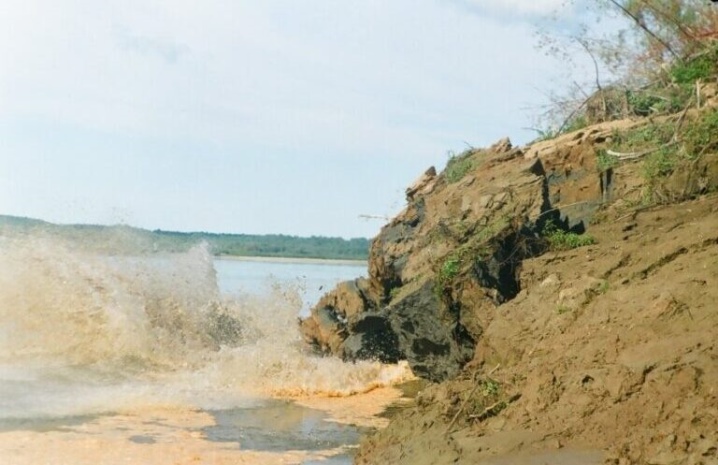
Strengthening river banks with plants
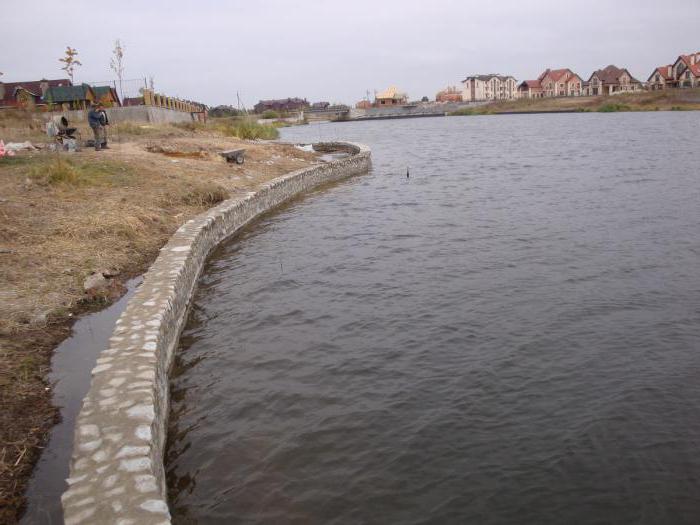
The riverbank can also be strengthened using plants for this. They must have a sufficiently strong, branched root system that is resistant to flooding. This method is acceptable only in cases where the speed of the river flow is not more than 1 m per second, while the waves do not exceed 0.3 m.The river bank can be strengthened with plants by herbaceous species of flora and shrubs, among them:
- amorph;
- swamp iris;
- manna;
- sea buckthorn;
Aquatic vegetation is planted in the underwater area, in this case, water iris can be used. Once the disembarkation has been carried out, a sodding should be carried out.
Making a pond with a bowl yourself
When independently constructing a pond at a summer cottage, it is allowed to use improvised items. This will help find use for old tubs, rubber tires and other materials.
From the old bathroom
Due to its strength and large volume, the cast iron bath is suitable for arranging a pond. Construction instructions include the following steps:
- The site is marked out taking into account the dimensions of the bath, adding 10 cm on each side, after which they dig a pit. Its depth should be 20 cm deeper than that of the container.
- At the location of the drain hole, an additional hole is made 50 cm deep and 30 cm wide.
- A sheet of steel rolled into a cylinder is inserted into the second pit and filled with gravel or crushed stone. This is necessary for the arrangement of drainage drainage.
- Layers of crushed stone and sand are poured onto the bottom of the main pit, the base is tamped and the steel sheet is pulled out.
- A bath is placed inside the pit so that the upper edges are at ground level. The drain hole must be above the drain.
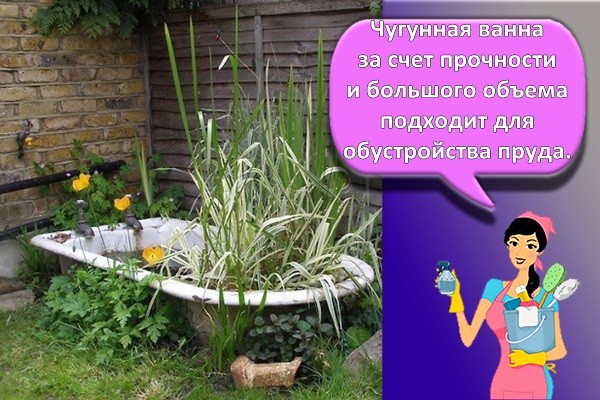
From a tire or other improvised means
A pond from car tires and alternative materials is made by analogy with the previous method. The only difference is in the shape and dimensions of the artificial reservoir.
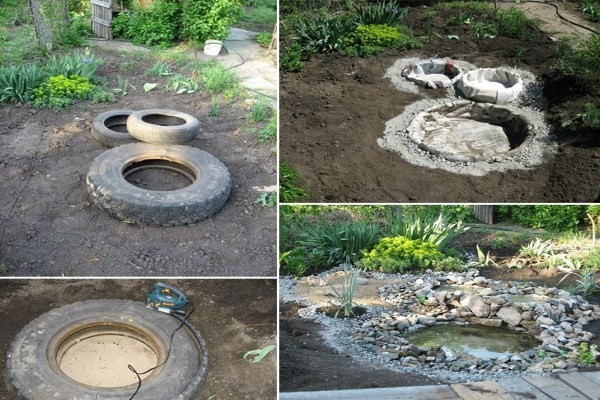
Variety of options for strengthening the coast
Before starting work, you need to decide on the reinforcement option, the materials used.
There are the following types and methods:
- Reinforcement with anti-erosion mesh. This material has high strength, flexibility and low weight. With the help of the roots of the planted plants, the geomat is firmly attached to the soil, forming a continuous reinforced canvas.
- With the help of a coconut mat, which consists of fibers of different density, interwoven with each other. This fabric is used to strengthen the banks of a pond, reservoir or river.
- Using a geogrid. This method is simple and highly decorative. In addition, the descent to the water will be convenient, and the cells of the lattice can be filled with any decorative filling, which will give individuality to your reservoir.
- Application of reinforcing mesh and tumbling stone.
- The use of gabions. A fairly simple method, represented by the construction of retaining walls in the form of boxes with stones. It is used in many cases, and sometimes it is simply irreplaceable when strengthening a sliding bank.
- Strengthening with plants (trees and shrubs). An environmentally friendly, aesthetic, but at the same time the most costly and complex way, because it requires a good knowledge of the necessary plants, which are selected in accordance with environmental conditions and soil characteristics. Therefore, this option is often not rational.
- The use of materials such as larch, oak, etc. This is an old and well-known method of bank protection, which is suitable for steep banks. It looks very original and beautiful, and the special properties of larch will allow the structure to serve for many years.
- Use of piles (metal, plastic or concrete). This is a fairly new option, which is suitable for steep coastal slopes. It is similar to the previous one in its execution.
It is best to strengthen the soil at the stage of the excavated pit, when you want to create an artificial reservoir.
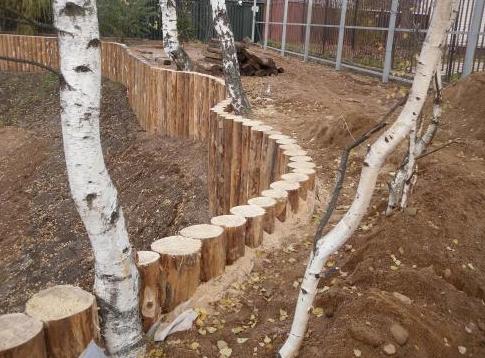
Reinforcement with larch
How to strengthen the shore of a reservoir with your own hands
If your house or land plot is located near the shore of a natural reservoir, or you have an artificial reservoir on your site, you need to think about strengthening the shore. Water has great destructive power and, if this is not done, the coast will gradually be washed away by water and destroyed. It is better to carry out the bank management of an artificial reservoir during the development of the pit or in the process of forming the bowl.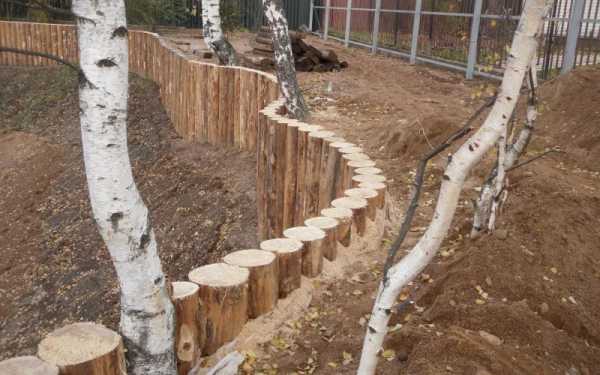
Strengthening of the shores of natural reservoirs is carried out at the time of the maximum decline in the water level - at the end of summer or in autumn. Measures taken in advance will prevent destructive processes and will save your finances.
This method allows you to strengthen the banks and at the same time leave the reservoir in its natural beauty. It can be used at a water flow rate of no more than 1m / s.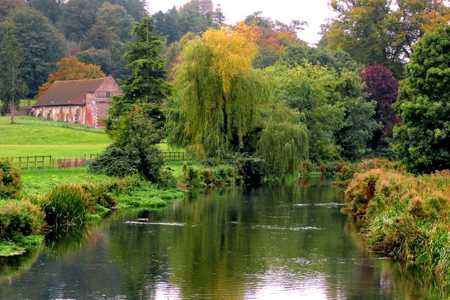
Special plants are planted that grow in nature on the banks of rivers and lakes. From trees it is - black poplar or weeping willow, from shrubs - sea buckthorn, red currant, bladder. Sedge, reed, marsh iris, cattail and other plants, whose natural habitat is near water, are necessarily used. The coastal land is completely covered with biomats made from natural fibers or ready-made turf. This method of strengthening the coast is considered the most expensive of all.
Use of natural stone
If the banks of the reservoir are capable of a slope of no more than 20˚, then the shore can be strengthened with pebbles and boulders of various sizes. Such a strengthening will give your shore a beautiful and unique look. The stones are laid on a supporting base - a geogrid or geotextile, this prevents stones from sinking into silt or slipping of the shore.
It is hard, painstaking work, but the results are worth it. The coastline looks natural and is well preserved.
Strengthening the banks with wooden piles
Another method of decorative beautification of the banks can be performed using wooden piles. This method is used if the soil around the reservoir is not mobile or loose. For the manufacture of piles, only hard tree species are used - larch, oak or acacia.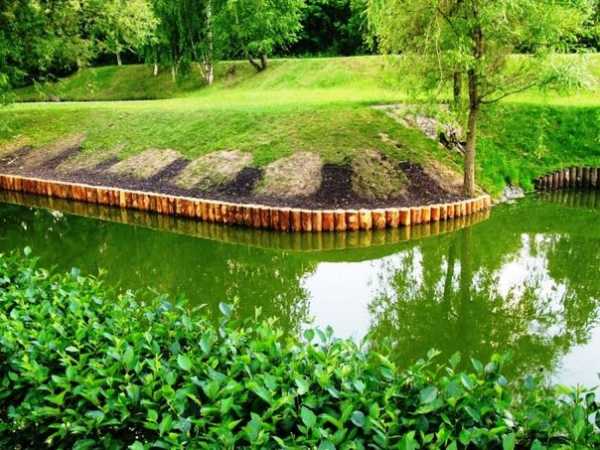
This method can be used on the steepest banks. Installation is carried out using a special technique or by hand. Such a strengthening looks most harmoniously next to buildings made of natural wood.
Using gabions
Carrying out work with the use of gabions is one of the methods of capital bank protection. Gabions are made of galvanized mesh and filled with natural stone during installation. The filled gabions are attached to the soil with anchors; they are also connected to each other in a solid structure. This method of strengthening the coast is widely used in Europe and guarantees the preservation of the clarity of the coastline for many decades.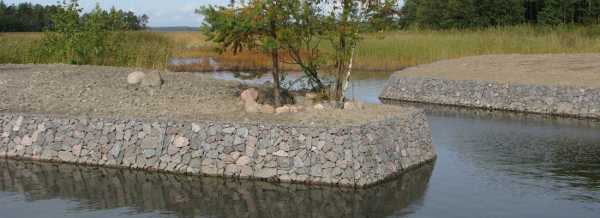
In addition, such a shore looks quite natural and is in perfect harmony with buildings lined with natural stone.
Strengthening the coast with PVC sheet piling
This method of capital bank protection is considered the fastest and most economical. It is used on steep and steep banks. Sheet piles are connected to form a single protective wall during installation. Their installation is carried out using special hydraulic equipment. The piles are securely fastened together with longitudinal ribs.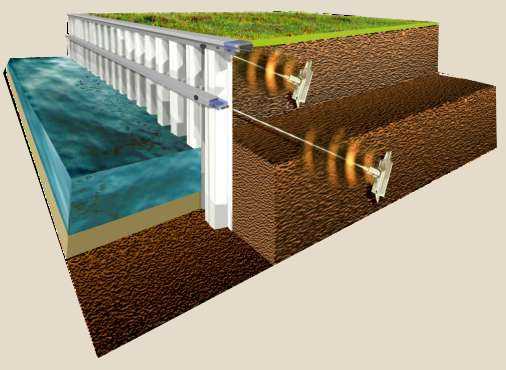
Capital methods of strengthening the banks reduce to a minimum the likelihood of their destruction for many years.
If you find an error, please select a piece of text and press Ctrl + Enter.
Additional activities
To do this, you will need to purchase seeds of perennial grasses or small trees and simply sow as densely as possible on the top of the coast and, if possible, on the steep slopes.
The second step will be to decorate the shore. If the shore is sandy, then you can simply dig in the visible parts of the coconut mat, and if it is grassy, you can throw more stones or earth - this will create additional strength and ensure the beauty of the entire shore.
There are many advantages of using coconut mat, here are the main ones:
- Environmental friendliness of the material, because it consists exclusively of natural elements.
- Cheapness is one of the main parameters if it is necessary to cover large areas.
- The installation work is very simple, even one person can handle it within a few hours.
- For several years, the slope will not erode or slide.
- The mesh structure allows plant roots to pass through for added strength.
- The strength of the material is not lost from sunlight, contact with water and from the decomposition of natural organic matter.
As you can see, your problem with landslides from constant contact with water can very quickly be solved with the help of your hands, because no additional knowledge is required. In addition, there will be no need for large monetary costs or obtaining permits from public authorities.
Spending only a couple of hours of your time, you will forget about the problem for 2-3 years, or maybe even more, because if there is a lot of vegetation on the shore, it will create plexus roots and its own mesh, which will continue to hold the shore after the decomposition of the coconut mat. Also, after a couple of weeks, no one will be able to guess that the coast is fortified, because the material will cease to be noticeable.
Important Factors
When organizing coastal strengthening, many factors should be taken into account. This will help you achieve good results.
Soil characteristics
First of all, it is worth familiarizing yourself with the key properties of the soil. There are soil types that tend to shatter.
Features of the coastline
Of no small importance is the assessment of the features of the pond shore
In this case, it is worth taking into account its height and the steepness of the slope.
How is the problem area located
It is definitely worth determining the localization of the pond. With this in mind, choose a method of strengthening
When performing work, it is important not to disturb the appearance of the site.
It is worth considering the purpose of the territory. The location of residential buildings and other structures nearby is important.

Climatic features
The climatic features of the area are of great importance. These include sharp fluctuations in temperature and the amount of precipitation.
Stage 2. Determining the material
There are a lot of materials that can serve as the basis for a decorative reservoir, but the most popular of them are the options below.
-
A ready-made plastic mold, for which you only need to dig a hole of the appropriate depth. A simple and fast way that does not require large financial costs. Its only drawback is that it is not always possible to give the reservoir the desired shape.
- A tough (often PVC) 0.5mm film is ideal for a small pond. For larger structures, it is advisable to use a denser material. Tellingly, when using the film, the pond can be given almost any shape.
In view of the fact that the construction of a decorative reservoir from a form can hardly cause any difficulties, we will consider in more detail exactly the second construction option.
Stage 5. Laying the film
Laying the film
Step 1. We cover the bottom of the pit with a 15-centimeter sandy "pillow", carefully tamp it.
Step 2. To protect the PVC film from damage, lay a layer of roofing material (overlapping).
Step 3. We cover the bowl of the reservoir with a film. We do it freely, with a small margin along the banks. Press the ends of the film with bricks.
Butyl Pond Film
Step 4. We fill the pond with water, but we are in no hurry to cut off the excess film. It is necessary to wait approximately 24 hours for the PVC coating to reach its final volume. Then we cut off the film, put its edges in a pre-made trench, tuck it in and fill it with rubble.
Giving individuality Laying stones on the edge Filling the pond with water Filling the pond with water
Arrangement and decoration
The process of constructing and decorating a reservoir depends on its type. There are several design options, from which you should choose the appropriate one, taking into account your own preferences.
Chinese
The Chinese reservoir is distinguished by the presence of bright and lush vegetation. You can arrange trees around the perimeter and build a classic Chinese convex bridge. As an addition to the design, it is allowed to use various decorative elements.
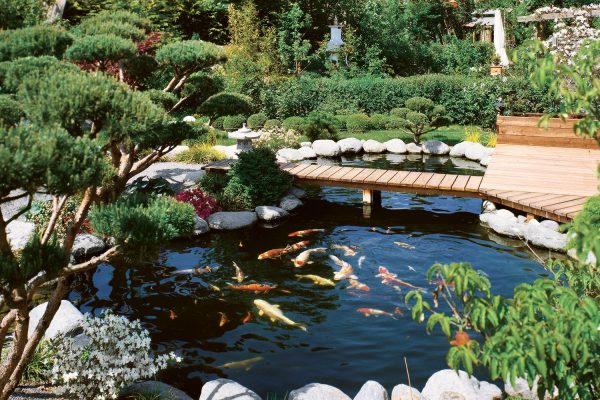
French
The French style pond has sophistication and elegance. It is distinguished by its neat shape and well-defined borders. The laconic geometry gives the pond the graceful look that is characteristic of France.
Italian
Symmetry is a characteristic feature of the Italian style. The reservoir is given the correct geometric shape and complemented by a fountain or a cascade. You can make the pond multi-level and decorate the perimeter of the plant with terracotta pots.

Japanese
When choosing a Japanese style, it is important to preserve the natural appearance of the pond. When decorating, only real miniature plants are used.
Often, Japanese ponds are decorated with figures of dragons, which will be reflected in the water.
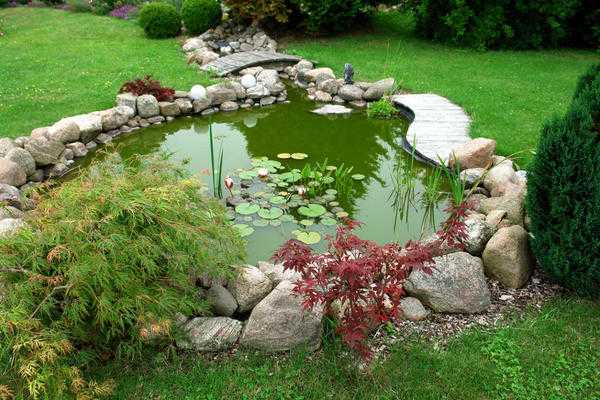
English
An English-style pond is the easiest to design, since there is no need to make clear boundaries. Lines can be smooth. The sides are decorated with an abundant amount of shrubs and trees.
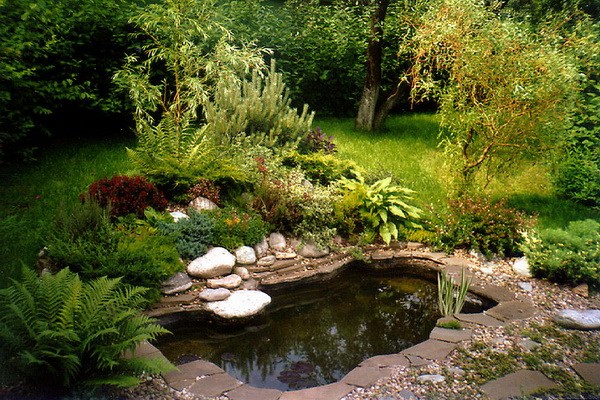
Good advice for arranging a reservoir
When building a pond, it is difficult to avoid some mistakes, especially a compositional plan. For this reason, you need to be aware of the common mistakes gardeners make.
| Plant growing zones | Plants |
|---|---|
| Coastal zone | Conifers, elderberry, ferns, meadowsweet, lilies of the valley, berry, etc. |
| Coastline | Lips, fluffy, kaluzhnik, veronica rucheinaya, snake mountaineer, forget-me-not, etc. |
| Plants for decorating shallow water (up to a depth of 5-20 cm.) | Calamus, reeds, umbelliferae, cattail, arrowhead, etc. |
| Deep sea plants 30-150 cm | Water lily, egg capsule |
| Plants for decorating the water surface (floating on the water surface) | Duckweed, vodokras, telorez |
Pond filter
-
First of all, this is container gardening. Yes, this option is described here, since it is the most common, but the fact is that the use of plastic containers interferes with the development of plants. Gardeners are afraid to cover the pond with earth, most likely due to the prospect of dirty water. But there is nothing to be afraid of, because the soil for aquatic plants contains a large amount of clay, which strengthens the roots and is not washed out by water. But if you still do not like this option, then do as described above.
-
Also, the banks are often decorated with stones of the same diameter. It is better not to do this, since such a body of water looks very boring. It is recommended to combine small stones with larger ones, but do not "go too far", that is, do not overwhelm the banks with them.
- Too deep ponds resemble, so to speak, bags of stone. According to recent studies, excavation companies find it more profitable to dig deeper water bodies because their services are paid for by cubic meters of excavated soil. But if fish farming is not in your plans, then a deep reservoir is completely useless.
Finally, having planned the independent construction of a pond, first practice - make, for example, a miniature pond, and only then move on to more dimensional compositions. This will greatly increase the chances of success.
A flowing water heater for a pond A living pond will not only delight your eye on warm summer evenings, but will also bring some benefits in the fight against insects The most attractive corner of the garden Pond in the country
Good luck with your work!



